News
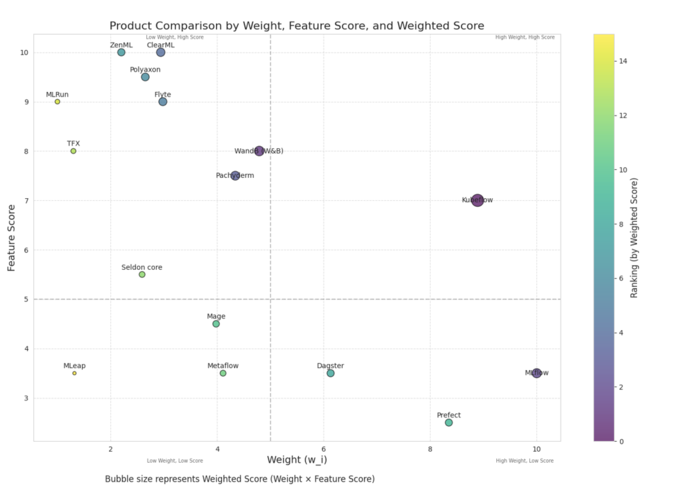
Researchers from the AI4EOSC project, whith KIT as a partner, have conducted a comprehensive study on the landscape of Machine Learning Operations (MLOps) and evaluated 16 widely used platforms.
Researchers from the AI4EOSC Project (with KIT as a partner) have conducted a comprehensive study on the landscape of Machine Learning Operations (MLOps) platforms, providing valuable insights into their features/capabilities and adoption metrics.
The study evaluated 16 widely used MLOps tools, focusing on capabilities such as experiment tracking, model deployment, and inference. The findings offer a decision-making framework to assist organizations in selecting appropriate MLOps solutions, whether they require end-to-end platforms or specialized tools.
Key Highlights:
Feature Analysis: The study presents an in-depth evaluation of 16 MLOps platforms, highlighting essential components for robust MLOps solutions.
Adoption Metrics: By assessing GitHub stars' growth, the research provides insights into the adoption and prominence of these platforms.
Decision-Making Framework: A weighted scoring method and a decision-making flowchart are introduced to simplify platform selection for organizations.
These insights are crucial for organizations aiming to initiate or enhance their MLOps strategies, ensuring scalability, reproducibility, and operational success in managing and monitoring machine learning models in production.
Further information:
AI4EOSC website
Publication in Springer Nature
Contact at SCC: Dr. Lisana Berberi
Achim Grindler
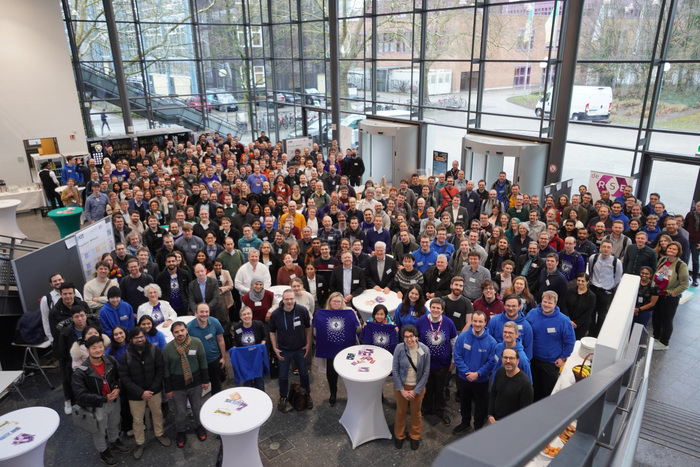
Over 300 research software and research software engineering enthusiasts came together in Karlsruhe for the deRSE25 conference.
From February 25 - 27, KIT and its Scientific Computing Center hosted the 5th conference for Research Software Engineering in Germany, the German conference for Research Software Engineers and people interested in Research Software.
Over 300 participants, national and international, came to Karlsruhe to present, discuss and contribute their insights, work and thoughts on Research Software and Research Software Engineering. In total over 170 contributions were scheduled in the three days of the conference, summing up to an stagering over 72 hours of content. The scientific program was framed by two inspiring keynotes from Bálint Aradi, University of Bremen, and Michael Felderer, Institute for Software Technology, German Aerospace Center and University of Cologne, presenting their view on the field of RSE and RSEs.
The deRSE25 conference was co-located with the Software Engineering 25 conference. Details on the conference, the program as well as many of the presented slides can be found on the conference hompage.
René Caspart
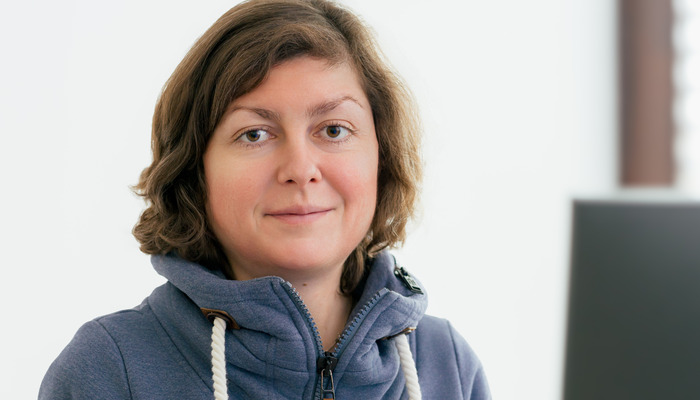
Prof. Dr. Nadja Klein has been awarded the Emerging Leader Award of the Committee of Presidents of Statistical Societies (COPSS), a prestigious recognition of her contributions to the field of statistics.
Prof. Dr. Nadja Klein, professor and lead of the Methods for Big Data research group, has been awarded the Emerging Leader Award of the Committee of Presidents of Statistical Societies (COPSS), a prestigious recognition of her contributions to the field of statistics.
This award honors early-career statisticians who demonstrate outstanding leadership and research impact. Nadja’s work spans Bayesian deep learning, computational methods, and spatial statistics, with a strong commitment to advancing statistical methodology, mentoring the next generation of researchers, and ensuring methods and software are accessible to researchers and practitioners.
The award will be presented at the Joint Statistical Meetings 2025 in Nashville, Tennessee.
SCC warmly congratulates Nadja Klein on this prestigious recognition.
Read more
Achim Grindler
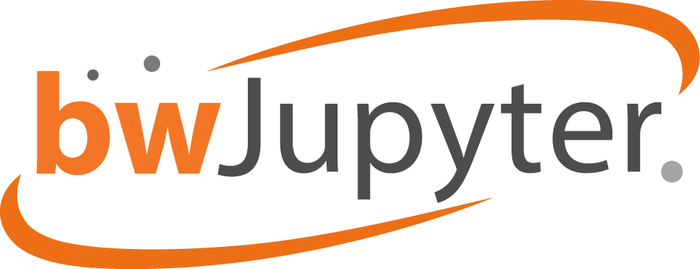
SCC and the University of Stuttgart are developing a new state service "bwJupyter for teaching", which is now available to all lecturers and students.
As part of the dialog process "Universities in the digital world" of the Ministry of Science, Research and Arts Baden-Württemberg, SCC and the University of Stuttgart are developing a new state service "bwJupyter for teaching".
Jupyter is a web application that provides users with access to computing environments and resources without burdening them with installation and maintenance tasks. After requesting a resource, the user is forwarded to a Jupyterlab environment. A central component of Jupyter is the Jupyter Notebook. This is a document that can simultaneously contain formatted continuous text, executable code sections and (interactive) visualizations (image, sound, video, 3D views).
In the past two semesters, selected courses have already been able to test the new service. Around 1000 users from six universities had access to the pilot hub during the winter term 24/25.
The new bwJupyterHub for teaching is now available to all lecturers and students. Registration is conveniently managed via the state-wide identity management system bwIDM; no additional registration is required.
With the state-wide opening, there are also numerous new features. For example, lecturers can create their own notebook profiles and share them with their students. In addition to the ten notebook options provided, such as Jupyter Datascience with Phython, R and Julia; Jupyter Tensorflow or Jupyter GPU, lecturers can now also use their own Docker images. Moreover, lecturers can share larger files and continuously edit course material via a shared directory.
Further features such as a grading function for exercise sheets and a connection to the ILIAS and Moodle learning platforms will be tested during the summer term.
Further information and detailed documentation
Dr. Jasmin Hörter
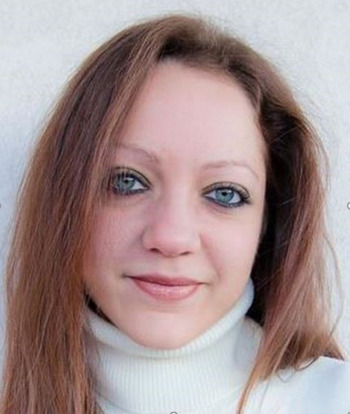
Rossella Aversa has headed the Data Exploitation Methods (DEM) department at the SCC since December 1, 2024. She took over from Rainer Stotzka, who previously headed the department and is now entering well-deserved retirement.
We are pleased to announce the appointment of Ms. Rossella Aversa as head of the Data Exploitation Methods (DEM) department at SCC. On December 1, 2024, She took over from Rainer Stotzka, who previously headed the department and is now entering well-deserved retirement.
After her studies, Ms. Aversa completed her doctorate in astrophysics in 2015 and also obtained a Master's degree in High Performance Computing in 2016. From 2016 to 2019, she worked as a PostDoc at the National Research Council in Trieste, researching new methods of research data management in connection with artificial intelligence.
She joined the DEM department at SCC in 2019 and took over as Head of Research & Development for Materials and Nanosciences in 2022.
The Data Exploitation Methods department researches new methods for research data and metadata management and develops software for data analysis and innovative services for efficient research data management. The most important areas of application are in materials science and nanoscience, digital humanities and the German National Research Data Infrastructure (NFDI).
Contact: Dr. Rossella Aversa
Achim Grindler

SCC has launched a centralized service for the efficient operation of IT infrastructure. To operate servers efficiently, organizational units can rent a fully operational data center unit at SCC.
In February 2025, SCC started pilot operations at Campus South for central server housing. The service provides data centre space for KIT organizational units to operate servers. Cabinets equipped with power supply and air conditioning can be rented for this purpose. The network connection of the cabinet can be selected from two variants. The cabinets are available in two different sizes and are secured by access control.
The service will run for one year in trial operation (pilot) and will then go into production following a review.
To the service description
Achim Grindler
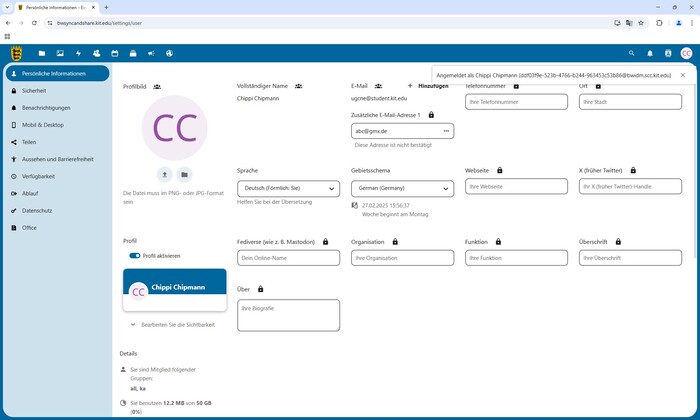
In bwSync&Share, additional email addresses can now be used to share data. "Collabora Online" has been running as a new online office solution since July 2024 and a database vulnerability was fixed in November 2024.
The bwSync&Share storage service has been given a new function that makes it easier to share files. When registering for the service, only the user's address stored in the federated identity management system bwIDM (= primary email address) is assigned and data previously had to be shared with exactly this email address. In the past, if a different email address was specified for the recipient when sharing, an additional guest account was created via which the data was shared. As a result, the shared data was not visible in the bwSync&Share account assigned to the primary email address.
With the new function, users can add additional e-mail addresses of their own to their bw-Sync&Share account. This means that data shared with these additional addresses will be available to users in the bwSync&Share account associated with their primary email address. Further information can be found in the FAQ for the bwSync&Share service.
In the middle of last year, the online office solution--> was successfully switched to Collabora Online in the service without any disruptions. This solution is based on a customized version of LibreOffice and is maintained and further developed as free software by Collabora Ltd. from Cambridge (England). Thanks to the close integration with Nextcloud, Collabora Online works seamlessly with the synchronization platform
In addition, after intensive troubleshooting with NextCloud and MariaDB support in November 2024, a vulnerability was identified and eliminated that was sporadically responsible for brief service interruptions in the past.
Sabine Lorenz
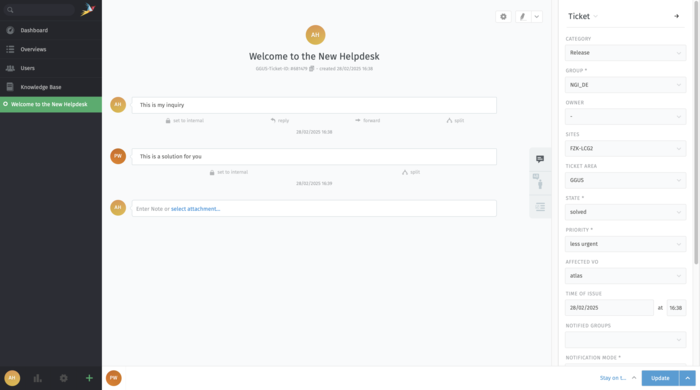
After more than 20 years of successful operation, the Global Grid User Support System (GGUS) developed at SCC is being replaced by a new ticketing system. The change was preceded by more than two years of research, consulting and custom development.
SCC at KIT is well known internationally for providing a ticketing system known as the Global Grid User Support (GGUS), used by the Worldwide LHC Computing Grid (WLCG) and European Grid Infrastructure (EGI) communities incorporating over 170 computing centres in more than 42 countries. The GGUS offers these large communities an integrated platform designed to handle user inquiries, incidents and service requests and coordinate between computing centres. The GGUS operations reinforce the principles of open-science, improving the accessibility of scientific research and ensuring the timely resolution of problems.
After over 20 years of successful operations, the SCC's custom-developed legacy GGUS system was replaced on January 29th by an open-source ticketing system developed by Zammad GmbH. The transition was preceded by more than two years of research, consultations, and custom developments that enabled the workflows established in the communities over the years of experience. The new ticketing system brings the communities a modern tech stack and new perspectives.
At the same time, the new Zammad's ticketing system also took over the xGUS, the child of the GGUS, serving smaller communities. The switchover of the ticketing system for the BW and KIT NHR support portals took place on February 19th.
SCC continues to host and enhance the new ticketing system for the communities mentioned above, as well as other communities such as European Open Science Cloud (EOSC).
Users are nostalgic about the legacy ticketing system that was home to their smart resolutions. At the same time, they warmly welcome the new system.
Contact at SCC: Dr. Pavel Weber, Dr. Aliaksei Hrynevich
Achim Grindler
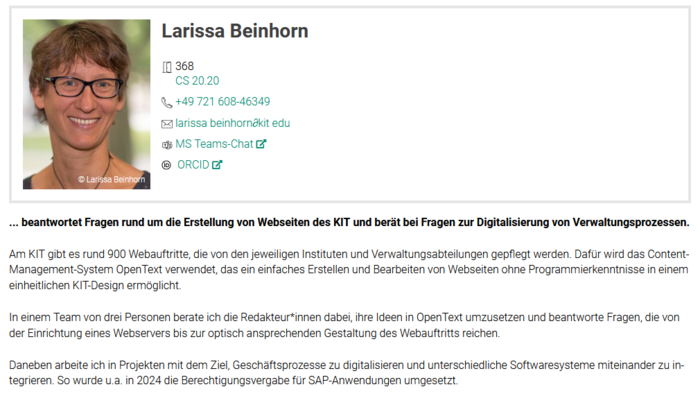
Create your short profile, add your ORCID or share your MS Teams link: discover the new possibilities in the SCC self-service portal my.scc.kit.edu
Example of a person page
Example of person list with new layout
To introduce persons, there are the person pages on the websites. With a data protection-compliant link to the KIT account, the content displayed on the person page can be edited in the SCC self-service portal and released for different areas (internal/external).
In order to publish person pages on KIT websites in compliance with data protection regulations, OpenText editorial staff members should use the import personal data from the communication directory function, which links the personal page to the person's KIT user account. In this way, each KIT employee can determine in the SCC self-service portal with what scope their personal data is visible, e.g. only on the KIT intranet or worldwide.
Further options have now been added to the attributes that can be released by the individual person: the ORCID, the Microsoft Teams link and a text field for a short profile. Once the data has been maintained and released as required, it is automatically displayed on the person pages.
Lists of persons have also been given a new layout that can be used, for example, to present the members of a research group in an appealing way, now also with the short profile entered in the self-service portal (figure below).
Contact: webmaster@kit.edu
Larissa Beinhorn
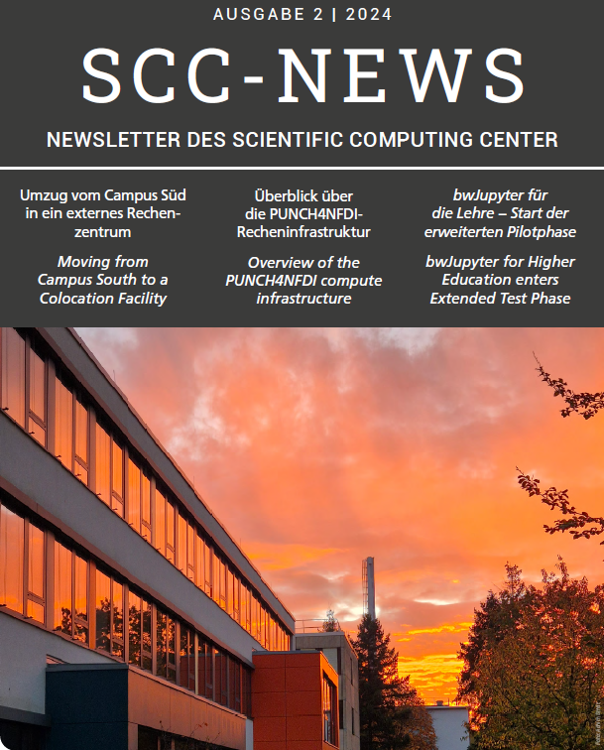
The new SCC News is online, including these topics: Moving from Campus South to a Colocation Facility; Overview of the PUNCH4NFDI compute infrastructure; bwJupyter for Higher Education enters Extended Test Phase.
Download SCC-News 2/2024
Dear readers,
A scientific computing center such as SCC is involved in all the missions of KIT: research, teaching, knowledge transfer, as well as the operation and support of fundamental IT services – internally, for "The Länd," in Germany, and beyond. Each of our target groups engages with information technology and research and development in a distinct manner. Even more intriguing: each target group "speaks" a different language and has unique needs and expectations – whether they are students, educators, administrative staff, or researchers across various disciplines. In a dynamic and innovative working environment like KIT, all infrastructures, services, and applications provided by SCC and its partners are essential.
The core competency for successful collaboration with these diverse groups, therefore, lies in translating their requirements into a language that is comprehensible to all stakeholders. None of the projects presented in this edition is alike.
On page 28, we provide an overview of how a federated IT infrastructure meets the highly complex requirements for data management and processing from national and international researchers in nuclear, astrophysics, and astroparticle physics.
A completely different clientele is involved in the pilot phase of the service "bwJupyter for Teaching”. This initiative aims to enable educators and students to efficiently and intuitively access tools for mathematical simulation alongside the appropriate computational resources (p. 37).
Even a seemingly mundane task, such as relocating IT infrastructure to an external data centre, engages a wide range of people – from service providers and SCC staff to participants KIT-wide. Read more about this extensive project on page 5.
Enjoy reading this edition!
Martin Frank, Martin Nußbaumer, Achim Streit
Achim Grindler
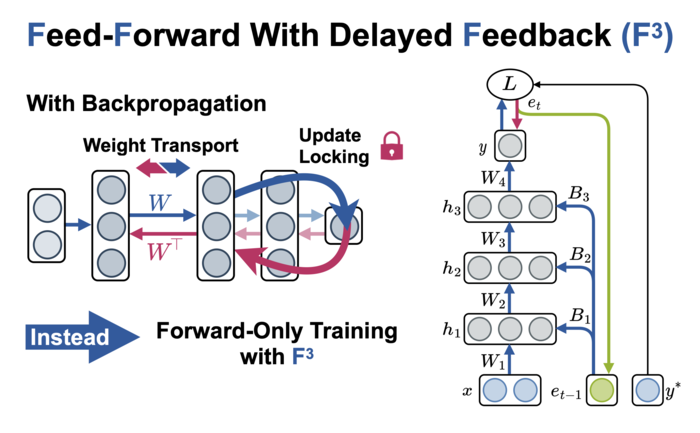
A team of SCC scientists won the Best Paper Award at the International Conference on Neural Information Processing in December 2024 for an alternative training approach for neural networks.
With the paper "Feed-Forward Optimization With Delayed Feedback for Neural Network Training," a team of SCC scientists under the supervision of Prof. Dr. Achim Streit won the Best Paper Award at the International Conference on Neural Information Processing 2024.
The paper introduces a novel method for training neural networks in a more biologically plausible and energy-efficient way by using approximate gradients. Typically, neural networks are trained using gradient descent, where the network parameters are iteratively updated by stepping into the direction of the negative gradient. The most common approach for computing such gradients is backpropagation, which computes the gradient in a backward pass. This backward pass, however, is biologically implausible, computationally expensive, and hinders parallelization. By using additional random feedback connections and delayed error information, SCC scientists introduce a new method to approximate the gradients using only forward passes. This not only solves two core issues of the biological implausibility but can also reduce the energy consumption per epoch by up to 25% and enables new possibilities for parallelization.
This work is funded by the Helmholtz AI platform and HAICORE@KIT grants.
Contact at SCC: Katharina Flügel, Dr. Markus Götz
Preprint: https://arxiv.org/abs/2304.13372
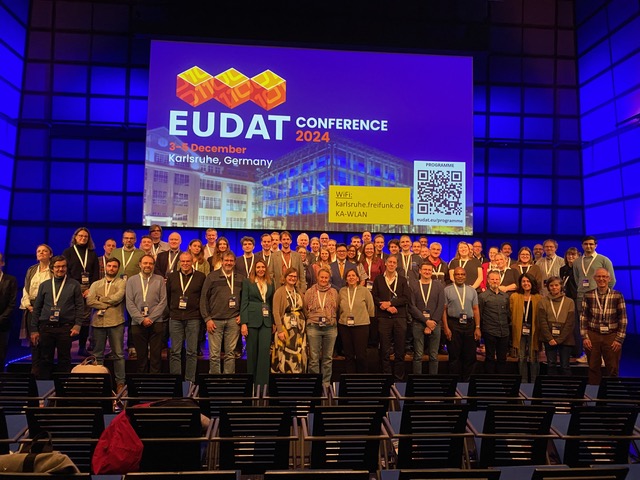
Science communities and data infrastructure providers work together to enhance scientific data services in Europe. An intensive exchange took place at the EUDAT Conference 2024 in Karlsruhe.
More than 110 participants from 20 countries took part in discussions on improving services and developing research data management at the conference organised with SCC. Speakers from the e-infrastructures EGI, EUDAT , GÉANT, OpenAire, from the scientific communities EBRAINS, Helmholtz AI, ENVRI-Hub NEXT, OSCARS, eLTER and others, adding supported by such as EOSC EU Node, Base4NFDI, FAIRCORE4EOSC and EOSC Beyond met an interested audience in the premises of the world-renowned Center for Art and Media Karlsruhe, ZKM. The presentations as well as the discussions and informal talks on the conference floor showed the interest and the necessity to intensify the cooperation with research and research organisations and providers of interoperable and international data services and their developers.
KIT is a member of EUDAT CDI, one of the leading European data infrastructures providing services to over 100 communities and groups.
Jos van Wezel

The topics on the agenda of the 28th ITB Assembly met with great interest. Over 300 people attended to find out about innovations to the SCC's range of services.
The SCC welcomed over 300 people from around 120 organizational units.
The information on the urgent need for action in the context of the certification service (KIT-CA) was particularly important. The IT officers received information about necessary measures after it recently became known that the CA service provider Sectigo had surprisingly terminated its contract with GÉANT early. This means that the issuing of certificates at KIT will no longer be secured from 01.10.25 and certificates that expire in 2025 should in any case be renewed by the end of the year 2024.
Mr. Axel Maurer explained the technical basis of the KIT-Card and highlighted the security aspects of the KIT-Card. The KIT-Card meets the highest security requirements (Commen Criteria certification of EAL5+) if it is used by applications with DESFire. Interested parties are welcome to contact the KIT-Card Service Team if they have any questions regarding the use of the KIT-Card for specific applications.
The portfolio of services offered by the SCC is constantly being expanded. We also took a look at new and future IT services at the SCC.
With a view to the M365 roadmap, the SCC provided information about the introduction of Microsoft OneDrive and SharePoint online. OneDrive will be offered as an additional data service at KIT in the future. The pilot phase in which various organizational units at KIT are participating is currently underway. OneDrive and Teams are based on SharePoint online, which means that SharePoint online can soon be used by several teams to manage documents. The SCC is calling on interested IT officers to participate in the development of these services.
The digitalization of administrative processes is already supported by the new KIT approval portal, which is described in detail in our SCC News 01|2024. A few processes have already been implemented there.
From 02/2025, the SCC can offer the organizational units at KIT data center space on the South Campus for the operation of server systems. The infrastructure and characteristics of the future “server housing” service were presented.
And AI is not stopping at the SCC's portfolio of services either. A new service will support transcription with OpenAI Whisper on local hardware and enable translation by the EU eTranslation service, while the two state projects bwCloud3 and bwJupyter are concerned with the addition of corresponding AI components (LLMs, Runner Harbor, K8s), among other things.
Further information and topics can be found in the presentation for the ITB meeting.
Birgit Junker

The "Cloud Management" working group of the ZKI e.V. met on November 13/14, 2024 at the SCC of the KIT to discuss cloud strategies and experiences.
Translated with DeepL.com
Dr. Martin Nußbaumer, Director of SCC, and Torsten Prill, Chairman of ZKI e.V., welcomed the 58 participants to KIT Campus South. The agenda focused on two main topics - on the one hand, the different aspects of the cloud strategies of universities and colleges and, on the other hand, practical experience with the cloud computing models Infrastructure as a Service (IaaS) and Platform as a Service.
The presentations on "Cloud strategies of the federal states and universities" showed a wide range of possible ways of dealing with "the cloud" and inspired a very lively exchange, as did the "(Practical) experiences with the use of IaaS and PaaS, especially at universities".
However, both focal points only represent small sections of the overall complex of the "Cloud Management" working group, as the joint identification of topics for the future of the working group showed. In addition, the report Cloud Management - Changes in administrative and provisioning processes, to which many working group members contributed, has now been officially published.
Patrick von der Hagen, Ulrich Weiß

On October 31, Daniel Coquelin defended his dissertation and successfully completed his doctorate at the KIT Department of Informatics with this important step.
Mr. Daniel Coquelin successfully completed his dissertation on 31.10.2024. His research focus in recent years has been on distributed machine learning.
Mr. Coquelin has made valuable contributions to distributed machine learning, particularly in the area of data parallel neural networks. His early work focused on communication-avoiding approaches to data parallel training. He then investigated the behavior of neural networks during training, observing that the orthogonal basis of weight matrices tends to stabilize during training. Based on this insight, he developed a novel method for training low-rank neural networks on distributed memory systems. This method allows for efficient scaling of training across multiple devices, leading to compressed neural networks that can outperform their full-rank counterparts. His work has implications for large-scale applications like natural language processing and computer vision. Mr. Coquelin's work was funded by the Helmholtz Analytics Framework (HAF) project and the Helmholtz Artificial Intelligence Cooperation Unit (Helmholtz AI) platform.
SCC congratulates Mr. Coquelin on the successful completion of his doctorate and wishes him all the best for his future career.
Dissertation of Daniel Coquelin: Optimization of AI Methods on Distributed-Memory Computing Architectures
[1] Prof. Ina Schäfer (KIT, Chair of the Examination Board), Prof. Achim Streit (KIT, first supervisor), Prof. Håkan Grahn (Blekinge Tekniska Högskola (BTH), Sweden, external examiner/opponent), Prof. Ralf Reussner (KIT, examiner) , Prof. Thorsten Strufe (KIT, examiner)
Achim Grindler

Tim Niklas Uhl from KIT was one of the winners of this year's Golden Spike Awards. They were presented at the 27th Results and Review Workshop. The conference took place on October 10 and 11, 2024 at KIT.
On October 10 and 11, 2024, the 27th Results and Review Workshop took place at the Karlsruhe Institute of Technology (KIT). The two-day conference, which brought together users of the supercomputers of the High Performance Computing Center Stuttgart (HLRS) and the Scientific Computing Center (SCC), highlighted modern applications of high performance and supercomputing (HPC) and provided a platform for presenting research results and discussing issues of application performance and scalability of HPC.
Prof. Dr. Martin Frank (Director of the SCC, KIT) and Prof. Dr. Thomas Ludwig (Director of the DKRZ, Hamburg and Chairman of the Steering Committee) welcomed the participants to the event.
Current research results from computational fluid mechanics, climate research, computer science, reactive flows and other disciplines such as chemistry and materials science, bioinformatics, astrophysics and particle physics were presented in 21 lectures and a poster session. In addition to traditional HPC simulations, machine learning methods and strategies for improving energy efficiency were also discussed.
One of the highlights was the presentation of the Golden Spike Awards to outstanding research projects. Among the award winners was Tim Niklas Uhl (Institute for Theoretical Computer Science, KIT), who was honored for his work on scalable algorithms for big data applications.
Presentations from the KIT
Numerical Study of Shock-Wave Interaction with a Fully-Resolved Cloud of Immobile Particles (Swagat Kumar Nayak and Markus Uhlmann, Institute for Water and Environment)
Modeling of Composition-Climate Interactions with ICON-ART (R. Ruhnke, P. Braesicke, L. Feld, P. Dietz, V. Hanft, K. Satitkovitchai, B.-M. Sinnhuber, M. Sinnhuber and S. Versick, Institute for Meteorology and Climate Research - Atmospheric Environmental Research)
Providing Climate Information Inferred from Kilometer-Scale Modelling (Hendrik Feldmann, Marie Hundhausen, Evgenii Churiulin, Christine Mihalyfi-Dean, Joaquim G. Pinto, Institute of Meteorology and Climate Research - Tropospheric Research)
Climate Change and Health in Sub-Saharan Africa: High-Resolution Dynamical Climate-Malaria Transmission Modeling near Victoria Lake, Kenya (Mame Diarra Bousso Dieng and Joël Arnault, Institute of Meteorology and Climate Research - Atmospheric Environmental Research, KIT-Campus Alpin)
Scalable Discrete Algorithms for Big Data Applications (Lukas Hübner, Florian Kurpicz, Peter Sanders, Matthias Schimek, Dominik Schreiber, Daniel Seemaier, Tim Niklas Uhl, Institute for Theoretical Computer Science - Algorithm Engineering)
Posters from the KIT
DNSPImpJets_HLRS: Reynolds Analogy in Smooth-Wall Turbulent Impinging Jets (Francesco Secchi, Institut für Strömungsmechanik)
Turbulent Drag Reduction on a Transonic Airfoil with Shockwave Blades (Davide Gatti, Niccolo‘ Berizzi, Sergio Pirozzoli, Maurizio Quadrio, Institut für Strömungsmechanik)
Anharmonic Correction to Adsorption Free Energy of O-Species on Pt(111) Surface from Thermodynamic Integration Using MLFF-MD Simulations (Thanh-Nam Huynh und Dmitry I. Sharapa, Institut für Katalyseforschung und -technologie)
Further information:
www.hlrs.de/event/2024/review-ws-27
www.hlrs.de/news/detail/winners-of-the-2024-golden-spike-awards
Carolin Breitzke
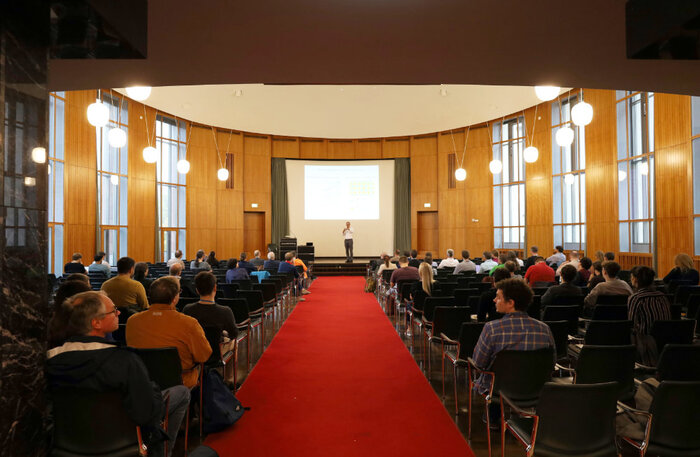
This year's bwHPC anniversary symposium took place on September 25 and 26, 2024 with over 80 participants in Freiburg im Breisgau.
On September 25 and 26, 2024, the 10th bwHPC Symposium took place at the University of Freiburg. This year's anniversary event attracted over 80 participants, who presented current developments in the field of high-performance computing (HPC). Over the course of two days, the bwHPC Symposium provided a platform for the exchange of knowledge and ideas in order to strengthen the role of HPC in research. Numerous scientists from all over Baden-Württemberg contributed their work. KIT was also represented by 23 researchers and contributed in the form of a tutorial, a poster presentation and two talks.
Contributions from KIT
On the first day of the symposium, Dr. Robert Barthel, with the help of Martje Armbrecht and Peter Weisbrod, led a tutorial on Introduction to HPC, which offered participants a comprehensive introduction to the use of the bwHPC infrastructure. The tutorial began with an introduction to the infrastructure and the objectives of the bwHPC-S5 project and provided information on how to access the resources. In addition, bwHPC services such as proactive user support were discussed. The first steps for using the bwForCluster and file transfer under Linux and Windows were then explained and an overview of the various data storage services was given. This was followed by an explanation of how to set up and run jobs on a cluster. Another important aspect was the use of different file systems on the clusters. This practice-oriented tutorial enabled participants to get straight into working with HPC clusters and gain valuable experience for their research.
KIT was also represented at the poster session. Ludmilla Obholz and Uwe Falke, with the help of co-authors Andreas Petzold and Serge Sushkov Evdoshenko, presented a poster on the Large Scale Data Facility at KIT (LSDF2), which is the central online data storage system available to all scientists and plays a key role in the storage and processing of large scientific data sets.
Sebastian Brommer's presentation on High Performance Computing Infrastructure for Particle Physics: The Experience of the Karlsruhe Groups was particularly exciting. Brommer explained the essential role of flexible and scalable computing resources for particle physics. At the Institute for Experimental Particle Physics (ETP) in Karlsruhe, the Overlay Batch System (OBS) is used as a uniform access point, which dynamically integrates additional computing resources from external locations using the meta-scheduling tool COBalD/TARDIS. The bwForCluster NEMO is a central resource that is used for simulations and data analyses in the context of large collaborations such as ATLAS, CMS and Belle II.
Another important contribution was made by Matthias Schnepf, who emphasized the role of the NEMO cluster in research into particle physics and dark matter in his presentation Belle II on NEMO: Flavour and Dark Matter Physics. He emphasized how HPC systems efficiently support the analysis of the enormous amounts of data generated in these physics experiments, sometimes through simulations.
About bwHPC
The bwHPC program is an initiative of the state of Baden-Württemberg that offers researchers access to high-performance computing resources for data-intensive research projects. The annual bwHPC symposium promotes exchange and interdisciplinary cooperation in the field of high-performance computing.
The symposium takes place every year, and we are already looking forward to participation and attendance at the bwHPC Symposium 2025!
Further information on the symposium can be found on the bwHPC website.
Carolin Breitzke
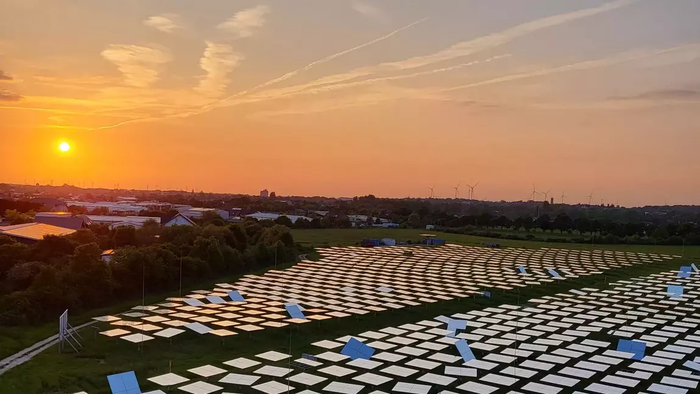
In collaboration with DLR, researchers at Helmholtz.AI are developing an AI-supported heliostat optimization. Heliostats are sun-tracking mirrors for solar thermal power plants. This significantly increases the efficiency of the power plants.
At a test facility in Jülich, operated by the German Aerospace Center (DLR), nearly 2,000 mirrors are aligned to reflect sunlight onto an absorber atop a tower. These solar tower power plants can complement wind and photovoltaic energy as a renewable energy source. The heat they concentrate can be used to generate electricity, power thermal industrial processes, or even stored for use during nighttime or in calm wind conditions. Like other renewable technologies, solar thermal power plants face significant cost pressures. To stay competitive, cost-saving measures are essential. Given that heliostats are a key expense, optimizing their production and performance is crucial. Currently, the mirrors are not perfectly flat, leading to uneven heat distribution at the tower, requiring high safety margins and thus reducing efficiency.
Researchers from the German Aerospace Center (DLR), together with consultants from Helmholtz.AI at Forschungszentrum Jülich (FZJ) and SCC at KIT, have therefore developed a new AI-based method to easily detect irregularities in the mirrors. Their results have been published in Nature Communications.
Further information on the Helmholtz.AI website
Publication in Nature Communications
Contact at SCC: Dr. Markus Götz
Achim Grindler
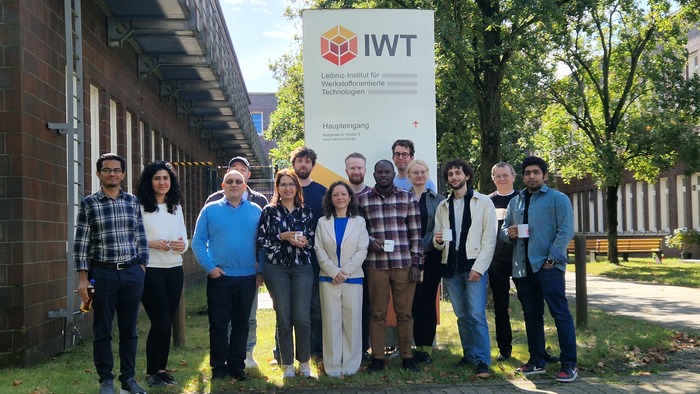
From 10 to 12 September 2024, the NFDI-MatWerk Summer School on Research Data Management in Materials Science and Engineering took place in Bremen.
From 10 to 12 September 2024, the NFDI-MatWerk Summer School on Research Data Management in Materials Science and Engineering took place in Bremen, hosted at the University of Bremen and organized by the scientific consortium National Research Data Infrastructure for Materials Science & Engineering (NFDI-MatWerk).
The aim of this summer school was to guide researchers to put FAIR principles into practice focusing more on the research area Materials Science & Engineering.
Dr. Rossella Aversa and Sabrine Chelbi, both from SCC, held two lectures: “The journey towards Metadata Management”, representing the theory part about understanding the importance and the added value of metadata, and “Metadata Management in practice using MatWerk tools”, including specific metadata management tools offered by NFDI-MatWerk as well as various tutorials and hands-on activities.
The attendees participated actively and manifested their positive feedback in the final survey.
Dr. Rossella Aversa, Sabrine Chelbi
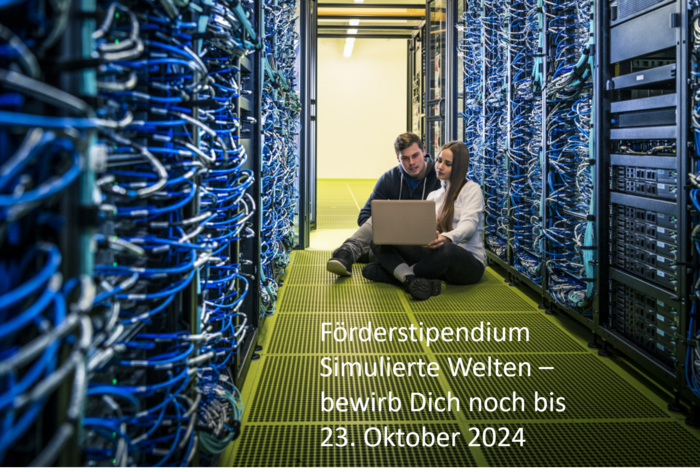
High school students can still apply until October 23, 2024.
In 2024, enthusiastic students can once again apply to conduct research at the SCC as part of projects related to computer science and mathematical modeling. The projects are supervised by SCC scientists and deal with topics from simulation, high-performance computing, management and analysis of large amounts of data.
More information at s.kit.edu/fssw
Achim Grindler
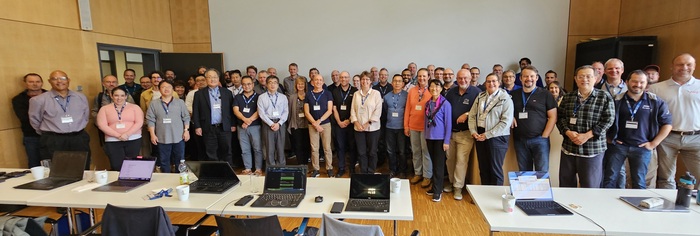
SCC held an International User Forum for the High Performance Storage System (HPSS) from September 9 to 12. The Forum is an exchange platform for all institutions that use and operate HPSS.
SCC held an International User Forum for the High Performance Storage System (HPSS) from September 9 to 12. There were 60 participants from 26 HPSS facilities. Of these, 30 were from Europe, 24 from America and Canada and 6 from Asia. The User Forum is an exchange of all facilities that use HPSS.
The HPSS storage software fulfills the most demanding requirements for long-term scalable storage requirements. Magnetic tape is the most economical storage solution for infrequently accessed data and is often referred to as "zero-watt storage". However, read access to tape data can also be scaled efficiently with the right installation. There is no one way to set up an HPSS, and each facility adapts it very precisely to its own needs. Typically, an HPSS is used by facilities that want to store large amounts of data over a long period of time. Many of these institutions deal with weather or climate research data, which is usually kept for a long time. The SCC certainly does not operate the largest installation, but it is one of the most active and innovative facilities that gets the maximum out of the hardware and achieves very good throughput rates. The German Tier 1 center for the Large Hadron Collider GridKa operated at SCC and the bwDataArchive service use an HPSS as tape storage technology. A disaster recovery installation for the Large Scale Data Facility to store large volumes of scientific data is also being set up.
During the user forum, both the developers reported on the next innovations and the use of their installations and the associated peculiarities. There were also reports on how and with which tools the systems are monitored. Efficient system monitoring is essential, as bottlenecks or problems need to be identified quickly in order to be able to react accordingly.
The HPSS community describes itself as a "big friendly family" in which a good exchange is maintained and people help each other.
During the four days:
shared operational experiences and the various HPSS upgrades and lessons learned
Techniques for managing workload performance were presented in order to organize data on tape and optimize tape drive access.
HPSS monitoring tools and scenarios of how end-user interfaces utilize HPSS were presented
Diagnostic and troubleshooting guides for tape drives explained
told "horror stories" from sites and how they overcame them
and last but not least, reports on new projects that the sites are working on.
In addition to the many technical presentations and lively discussions, there was a GridKa tour and a social get-together with a delicious tarte flambée meal at the SCC. The Schlosslichtspiele Karlsruhe were a highlight of the social program and the excellent conference dinner was accompanied by a museum tour about AI at the Center for Art and Media (ZKM).
Doris Ressmann
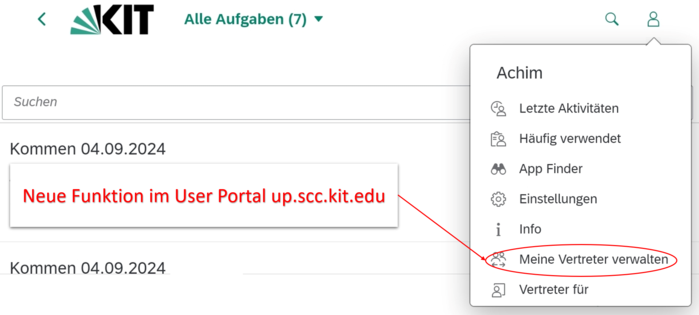
In the User Portal (UP), approvers can now set up substitutions directly in the inbox to ensure a smooth transition for approval processes in the event of absences.
Since mid-August, substitutes for the approval of HR tasks (time bookings, absence requests) can be set up in the Inbox. To do this, open the Inbox and then select the "Manage my substitutes" function via the button for your own profile at the top right. You can create planned and unplanned substitutions, which must then be activated by the person taking over the substitution.
With the introduction of the easyBANF app, the successor system for the SRM procurement system, planned for September 18, substitutions for the approval of shopping baskets can also be set up.
More information on the inbox and setting up substitutions.
The UP(up.scc.kit.edu) is constantly being expanded with new functions. Current information can be found in the news app in the UP or on our website.
(translated with DeepL.com)
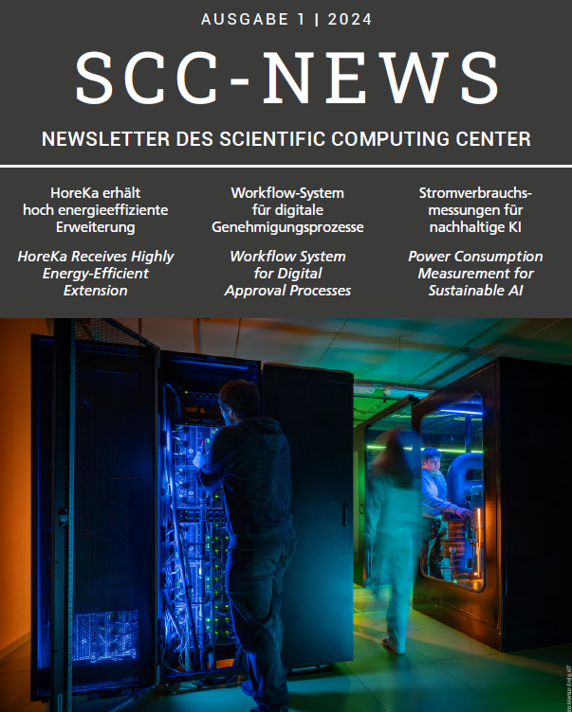
The new SCC News is online, including these topics: HoreKa receives highly energy-efficient extension; workflow system for digital approval processes; power consumption measurements for sustainable AI.
Download SCC-News 1/2024
Dear reader,
IT companies such as Google and Microsoft are increasingly using artificial intelligence (AI) in their products. The huge computing power required for this is usually provided by state-of-the-art graphics processing units (GPUs). These in turn require a lot of electrical energy to process AI algorithms. But how can modern computer systems run more efficiently and sustainably without slowing down progress? In this issue, SCC shows you some of the changes that can be made.
First, it is important that computer systems can perform more calculations with less energy. Our supercomputer HoreKa has demonstrated this impressively after its new upgrade. It is now the sixth most energy-efficient computer in the world (p. 20). Another option is to generate the required electricity locally from renewable energy sources. KIT is currently installing several large solar systems on the roofs of its institutes. The roof of the SCC buildings alone will have a peak output of about 500 kW.
There is also room for improvement in software. Initiated by SCC the research community has started to discuss how measuring the power consumption of AI software can serve as a sustainability metric (p. 23). However, it is not only energy saving that contributes to sustainability in IT. One example is the sustainable storage of research data. The SCC is developing concepts that will enable researchers from different disciplines and locations to work efficiently with existing data (p. 5 and 27).
Finally in this SCC News, we talk about digitalisation of KIT's business processes – i.e. electronic workflows – which will further reduce errors, working time, and paper consumption (p. 16). Speaking of paper: starting with this issue, we will be sending out SCC News exclusively in digital form and in a new layout.
Enjoy reading!
Martin Frank, Martin Nußbaumer, Achim Streit
Achim Grindler
_rdax_700x467s.jpg)
Prof. Dr. Nadja Klein leads the newly established research group Methods for Big Data (MBD). It develops novel statistical and mathematical approaches at the intersection of Bayesian statistics and machine learning.
In August, Professor Nadja Klein was jointly appointed to the Professor Methods for Big Data by the Department of Informatics and the Scientific Computing Center (SCC) at KIT. Previously, Prof. Klein was Professor for Statistics and Data Science at Humboldt-Universität zu Berlin.
At SCC, Prof. Dr. Nadja Klein leads the newly established research group Methods for Big Data (MBD), which develops novel statistical and mathematical techniques for the quantification of uncertainties in statistical and machine learning by leveraging Bayesian statistics. MBD also tries to make models more robust and data-efficient via the integration of prior knowledge. The research activities of the MBD group focus on both theoretical and empirical aspects as well as on interdisciplinary projects where theoretically-based methods are tailored to applications. Further details about the group’s activities can be found at kleinlab-statml.github.io.
Achim Grindler

From 12 to 14 June 2024, the NFFA-Europe Summer School on Data Management and Virtual Access took place. The school in numbers: 3 days in Heraklion, 8 sessions, 29 participants, 12 instructors, 3 of which from SCC
From 12 to 14 June 2024, the NFFA-Europe Summer School on Data Management and Virtual Access took place in Heraklion (Greece), hosted at the Foundation for Research and Technology-Hellas (FORTH), as part of the training activities organized by NFFA-Europe, a Research and Innovation Action under the H2020 Work Programme. Dr. Rossella Aversa (one of the scientific organizers), Thomas Jejkal, and Nicolas Blumenröhr, all from SCC, travelled to Greece to hold their lectures.
The aim of the three-day Summer School was to guide researchers to effectively put FAIR principles into practice and to make use of Virtual Access services, a novel set of cloud services offered by NFFA-Europe, which includes innovative online simulation services, databases, machine learning services, data analysis and metadata management.
The instructors introduced specific data and metadata management tools (data management plans, repositories, metadata schemas) as well as each of the Virtual Access services. The sessions were widely supported by dedicated tutorials and hands-on activities.
The attendees, including technicians, graduate students, post-docs, and young researchers from academic and industrial communities, participated actively and manifested their positive feedback in the final survey.
Dr. Rossella Aversa, Thomas Jejkal
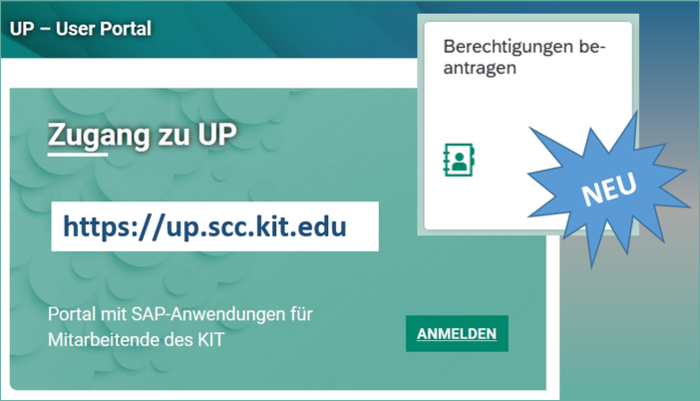
From mid-July 2024, the digital process for commissioning authorizations in the User Portal (UP) will replace the PDF application forms used to date, offering numerous advantages.
From July 10, 2024, a new function called "Request authorizations" will be available to KIT employees in the User Portal (UP). This is a digital form that KIT employees can use to apply for authorizations in the UP for themselves or for third parties and for authorized persons to approve them.
The digital form replaces the previously used PDF application forms, which will only be accepted until July 22, 2024.
The following authorizations can be applied for and approved via the digital procedure.
Finance and HR reports with BW
Creation and approval of shopping carts in SRM
Correct signature and approval of incoming invoices in AREB
Administration of guest and partner
Approval of person days
Once the application has been submitted, the person for whom the authorizations have been requested must first approve the application. The responsible manager then receives a notification by email to approve or reject the application via a link contained therein. If approved, the application is forwarded to the SCC and processed there as before.
The new digital process offers numerous advantages:
Support when completing the form: Users are guided through the form and, for example, are only given the valid account assignment elements (cost center, WBS elements) to choose from, depending on the information provided
Simpler approval: Approvers receive a notification email and can approve the request via a link. Signatures or digital signatures are no longer required.
Transparent and traceable process: The responsible line manager is automatically determined from the centrally stored information in the organizational management and the funds center plan. Applicants can track the status of the approval process.
Further information on the digital procedure or on authorizations in general can be found on Authorizations for UP. If you have any further questions, please contact our SCC Service Desk.
SCC Service Team
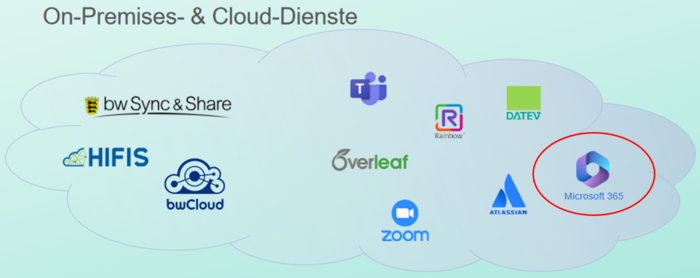
The way is clear for the cloud-based software platform Microsoft 365 at KIT. The Executive Board decides to provide such a platform for all employees.
At the end of May 2024, the Executive Board of KIT decided to provide all KIT employees with the cloud-based software platform Microsoft 365 (M365). The associated goal is to achieve a balanced use of the software in terms of maximum possible functionality on the one hand and data protection precautions and information security on the other. The Digital Office and the Scientific Computing Center (SCC) are commissioned to take care of the implementation and the further necessary steps in accordance with the roadmap for the extended use of M365 at KIT.
At the end of May 2024, the Executive Board of KIT decided to provide all KIT employees with the cloud-based software platform Microsoft 365 (M365). The associated goal is a balanced use of the software in terms of maximum possible functionality on the one hand and data protection precautions and information security on the other.
To this end, the SCC has developed a roadmap for the extended use of M365. We are gradually providing the following functionalities, among others:
Guest access to M365 services for collaboration with external parties
M365 access accounts for all employees
OneDrive and SharePoint-Online as online storage services
Intune for managing apps and settings on mobile devices
Hybrid provision of Microsoft Exchange for groupware functionalities, such as calendar use in MS Teams
The roadmap, aspects of security and data protection and the next steps were presented and discussed at the meeting of IT Commissioners in May 2024.
Achim Grindler
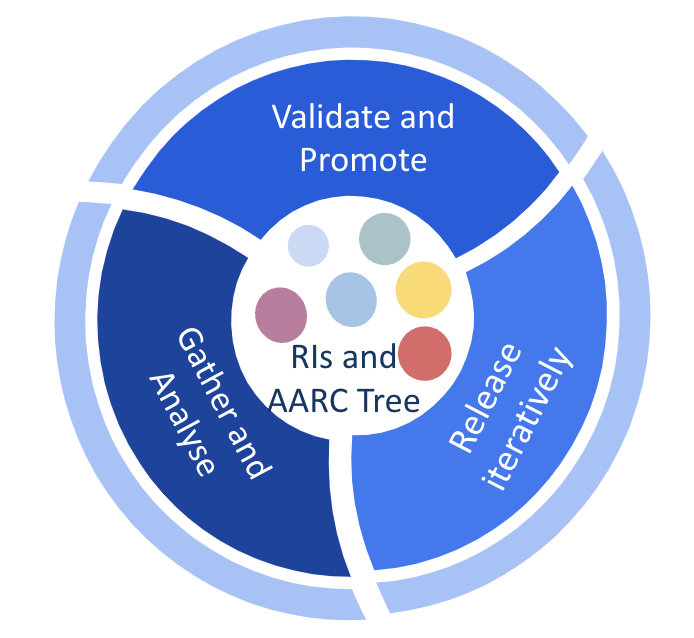
Based on the successful AARC Blueprint Architecture model, AARC TREE takes the integration of research infrastructures to the next level.
Collaboration and sharing of resources is crucial for research. Authentication and Authorization Infrastructures (AAI) play a key role in enabling federated interoperable access to resources.
The AARC Technical Revision to Enhance Effectiveness (AARC TREE) project takes the successful and globally recognized Authentication and Authorization for Research Collaboration (AARC) model and its flagship deliverable, the AARC Blueprint Architecture (BPA), as a foundation to drive the next phase of research infrastructure integration: Expanding federated access management to integrate user-centric technologies, expanding access to federated data and services (authorization), consolidating existing capabilities, and avoiding fragmentation and unnecessary duplication.
SCCs participates in AARC-TREE to continue developing the Blueprint Architectures. Here we contribute to technical recommendations, as well as to policy development. Since SCC is also a core member of the IAM project of the german NFDI, we can raise the awareness of NFDI requirements in AARC, as well as feed new developments back to NFDI, in a very timely manner.
Contact at the SCC: Dr. Marcus Hardt
Achim Grindler

More than 250 IT representatives (ITB) from KIT attended the 27th meeting to find out about new developments in the IT infrastructure and the IT services offered at the SCC.
The meeting of the SCC takes place twice a year in an online format.
This time, a total of 260 people from around 100 organizational units were welcomed.
In addition to the main topic of the introduction of Microsoft cloud services, which was the subject of lively and critical discussion, the agenda also included topics, changes and plans in the areas of studying and teaching, research and administration.
For example, the introduction of HISinOne STU in June 2024 and a state service with Jupyter (bwJupyter currently in the pilot phase) were reported on, as well as current information on plans in the User Portal (UP) for EasyBanf, new ESS/MSS functions and the assignment of authorizations.
The authentication and authorization infrastructure (AAI) operated centrally at the SCC is already used nationwide and is to be expanded. In future, further identities, including BundID, will be integrated into the AAI software RegApp developed by the SCC.
The presentation of this event, as well as all previous presentations, can be viewed by all members of KIT on the SCC's Partnership Cooperation website.
IT representatives (ITB) have the opportunity to report topic requests to the SCC at any time in the run-up to the next event in November 2024 and beyond. Employees should contact the ITB in their organizational units directly to submit any IT-relevant topics.
Birgit Junker
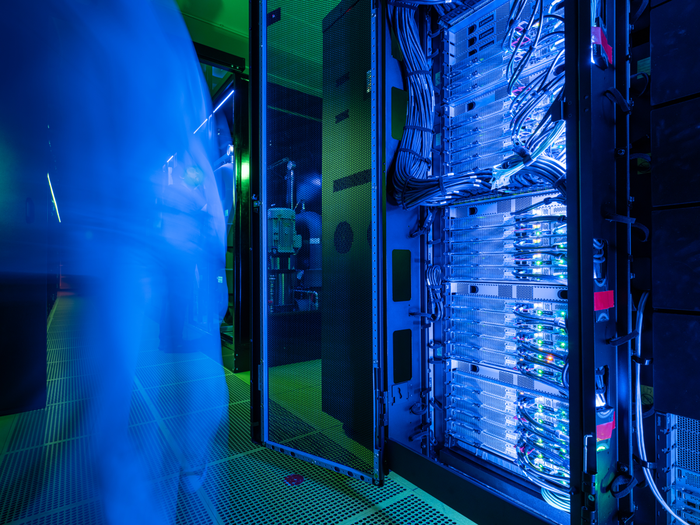
The Karlsruhe high-performance computer (HoreKa) is currently one of the fastest computers in Europe. A recent upgrade also puts it in 6th place in the biannual Green 500 list of the world's most energy-efficient computers.
The Karlsruhe high-performance computer(HoreKa) is being upgraded to a new level, including for use in high-scaling calculations with artificial intelligence and machine learning to solve complex scientific questions. The new components are combined in a separate partition, HoreKa-Teal (see photo), and contain 88 NVIDIA H100 accelerator processors. The systems are hot-water cooled and, with an energy efficiency of 63 GigaFLOPS (billions of computing operations) per watt, are among the top 10 most energy-efficient supercomputers in the world. HoreKa-Teal ranks 6th on the current Green500 list. This represents another significant improvement on the result when it was commissioned in 2021 (13th place). The total performance of HoreKa thus increases to over 20 quadrillion computing operations per second (20 PetaFLOPS).
To the press release of the KIT
Achim Grindler
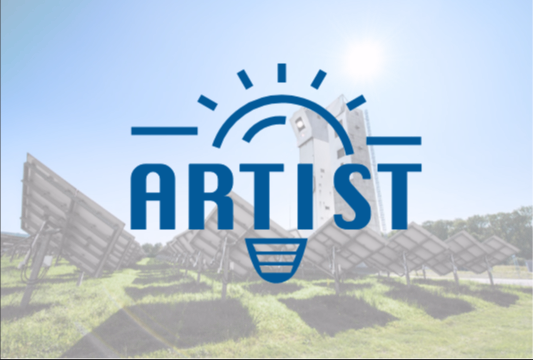
In the ARTIST project "AI-enhanced differentiable Ray Tracer for Irradiation-concentrating Solar Towers", researchers are developing a digital twin to optimize solar power plants.
Thermal solar tower plants are renewable energy facilities that use mirrors to concentrate sunlight onto a receiver. Here, the heat energy is collected and used for industrial processes or electricity generation without greenhouse gas emissions. Together with the German Aerospace Center, researchers at the SCC are creating a comprehensive digital twin of thermal solar power systems that can simulate how sunlight travels through these plants and collects at the receiver. Based on ray tracing principles, this simulation improves predictions of how much sunlight the mirrors will receive, thus optimizing their alignment to maximize the energy yield without overheating the receiver.
In the new ARTIST project, we aim to enhance a physics-based raytracer with artificial intelligence to create a data-driven digital copy of the power plant, which can then be used to design, control, predict, and diagnose issues during daily operations. This AI-enhanced system can optimize various aspects of the plant's operation, such as the mirror aimpoint, based on real-time conditions. In addition, we can explain certain operative actions in the plant's operation. We will test our digital twin at a real power plant in Jülich, Germany, marking a major milestone towards fully automated solar tower power plants.
Dr. Marie Weiel

The SOL-AI project, in which SCC is also involved, aims to accelerate the development and optimization of photovoltaic materials using state-of-the-art AI models.
In the SOL-AI project, KIT and partners combine the development of new generations of solar cells with state-of-the-art approaches to artificial intelligence (AI/AI) and machine learning (ML). The Scientific Computing Center (SCC) of KIT is represented by tenure-track professor Sebastian Krumscheid. Sebastian Krumscheid is a research group leader at SCC and an expert in uncertainty quantification (UQ). AI and ML are also used here in the design of new and more efficient materials for photovoltaics. The goal is to create an AI model that adapts to the diverse challenges of materials science.
The Helmholtz Association is funding a total of four projects on basic models for artificial intelligence. KIT is involved in two of these projects (see KIT press release).
Contact at SCC: TT-Prof. Dr. Sebastian Krumscheid
Achim Grindler

As part of the joint project “Materialized Holiness”, SCC researchers have the unique opportunity to visit one of the most valuable collections of literature in the world.
Admittedly, the words “Vatican Library” or “Sacred Manuscripts” do not immediately bring to mind computer science or the SCC. But digital research data management bridges the gap between the Vatican Library's valuable books and manuscripts and modern information science methods. As part of the joint project “Materialized holiness” funded by the Federal Ministry of Education and Research (BMBF), researchers from the SCC are working with experts in Jewish Studies and materials science to investigate medieval Torah scrolls and their transformation into the digital world. In particular, the question arises as to how the multi-perspective information content of the Torah scrolls can be converted into machine-readable, structured objects and data in order to enable targeted computer-aided analyses and visualizations. In order to study and collect this information, it is essential to view the real objects.
The Vatican Library's collection contains two medieval Torah scrolls as well as many other interesting manuscripts relevant to the project. In April, Laura Frank and Dr. Danah Tonne (both SCC) were granted access to the Biblioteca Apostolica Vaticana together with the Jewish Studies experts to examine these treasures. Under strict supervision and after many security checks, the researchers were allowed to examine the ancient, valuable objects for any special characteristics and differences. Laura Frank and Danah Tonne were not only able to gain deep insights into the work of the humanities scholars, but also clarify many questions about the data models designed and the technical implementation of their own research work.
Laura Frank
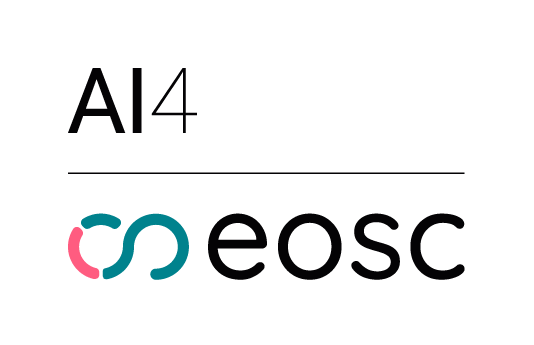
The AI4EOSC project announces the first Open Call for new Use cases! The goal is to onboard researchers, businesses, and innovators developing innovative solutions and support them by taking advantage of AI/ML/DL technologies.
AI4EOSC platform recently had its first release. It provides a user-friendly workbench and toolbox for developing and running AI models, tightly integrated with the EOSC (European Open Science Cloud).
With its first release, the AI4EOSC project announces the first Open Call for new Use cases! The goal is to onboard researchers, businesses, and innovators developing innovative solutions and help them improve their products and services by taking advantage of AI/ML/DL technologies and models within the EOSC. Research organizations, researchers, start-ups, spin-offs or, SMEs from EU countries (eligible for HE) are invited to apply for this Open Call.
For details: please, see this announecement
Deadline: extended to May 15, 2024, 11:59 pm CEST
Dr. Valentin Kozlov
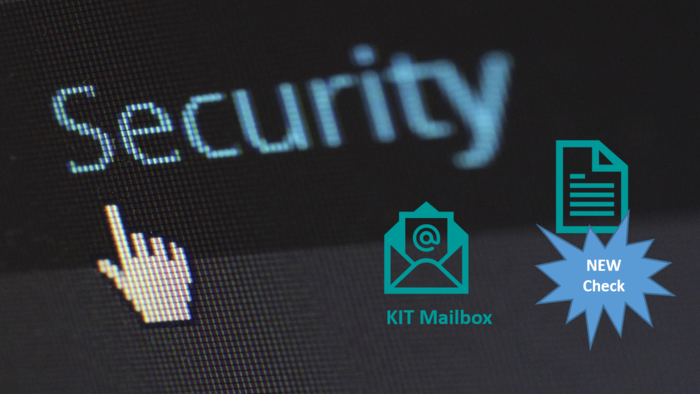
SCC now also checks internal e-mails that may pose a potential threat to the IT infrastructure at KIT. There is a particular risk potential when sending specific files as e-mail attachments.
E-mails with potentially dangerous files attached have long been blocked when sending to or receiving from external parties (see also Policy changes to incoming mail systems), as these files, such as Office files containing macros, are often used by attackers to infiltrate malware (so-called macro viruses). In order to close this popular gateway for attackers, SCC will increase the security of e-mail communication within the KIT and, for example, check e-mails for such potentially dangerous files and block them if necessary. The mail routing for KIT mailboxes will be adapted for this purpose.
From Tuesday, April 23, 2024, e-mails sent from KIT mailbox to KIT mailbox will also be checked. From this date, emails with potentially dangerous files attached will therefore be rejected and will no longer reach the target addresses.
This applies in particular to e-mails with the following attachments
RTF files or
Word/Excel documents with macros (*.docm and *.xlsm)
IMPORTANT: Please note the following information!
If it is necessary to send documents with such potentially dangerous document types internally, use mail encryption (S/MIME) or use the services provided for exchanging documents:
File exchange and online storage for desktop data (bwSync&Share)
KIT team pages
KIT data storage (OU directory)
MS Teams
matrix
etc.
Depending on the confidentiality of the data contained in these documents, use the appropriate file exchange service. Get also user guidance via the various service documetation.
Note
After the implementation of this extension and the associated improvement of IT security at KIT, sending e-mails via the smtp.kit.edu service from outside will again be possible without a Virtual Private Network (VPN).
Information about this change can also be found in our operational messages.
SCC Support Team

Sebastian Krumscheid erarbeitet mit Studierenden Konzepte für Problemlösungen aus aktuellen Anwendungsbeispielen. Er erhält für seine herausragende Lehre den KIT-Fakultätslehrpreis 2024: Mathematik.
Jun.-Prof. Dr. Sebastian Krumscheid lehrt an der KIT-Fakultät Mathematik und leitet am SCC die Forschungsgruppe Uncertainty Quantification (UQ). Seine Gruppe entwickelt moderne mathematische und numerische Techniken zur Behandlung und Quantifizierung von Unsicherheiten in komplexen Rechenmodellen.
An der KIT-Fakultät Mathematik vertritt Sebastian Krumscheid das Fachgebiet Uncertainty Quantification in der Lehre. In seinen Vorlesungen lernen die Studierenden moderne Methoden der angewandten Mathematik zu beherrschen. Sie lernen, die Unsicherheiten in mathematischen Modellen und komplexen Berechnungsmodellen zu quantifizieren und untersuchen gemeinsam mit Sebastian Krumscheid aktuelle Anwendungsbeispiele des maschinellen Lernens, den Wirtschaftswissenschaften oder den Naturwissenschaften, um Lösungskonzepte zu entwickeln.
Die KIT-Fakultät Mathematik ehrt Sebastian Krumscheid für seine innovativen und praxisorientierte Lehrkonzepte zu hochkomplexen mathematischen Methoden mit dem Fakultätslehrpreis.
Das SCC gratuliert Herrn Krumscheid herzlich zu dieser Auszeichnung.
Achim Grindler
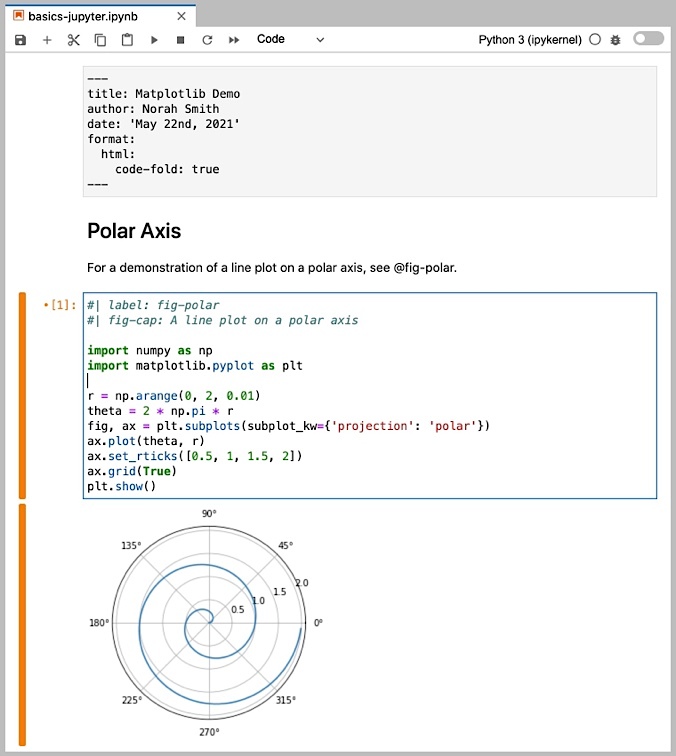
SCC is launches the pilot phase of the "JupyterHub for Teaching" service. The aim of the project is to strengthen research-oriented teaching at KIT, particularly in the areas of artificial intelligence, machine learning, simulation and modeling.
In the summer semester 2024, SCC will start the pilot phase of the new JupyterHub for Teaching service for teaching. The aim of the project is to strengthen research-oriented teaching, especially in the fields of artificial intelligence (AI), machine learning, simulation and modeling, by providing a KIT-wide JupyterHub.
Computer-aided modeling and simulation has long been used not only in the natural sciences and technology, but also in almost all areas of research, from social sciences and humanities to medicine.
Especially in the rapidly growing field of AI, the application possibilities are endless. This results in new demands on the skills of graduates from all disciplines. In order to be able to use the numerous tools effectively, training must include not only subject-specific topics but also teach knowledge of common programming languages and their use in computer-aided computing. In order for this to succeed, the entry level should be as low-threshold as possible and the handling should be simple.
The open-source software JupyterHub offers this possibility. The web-based, interactive environment enables students to test and execute code from the most common programming languages (including Julia, Python and R) without having to install software on their own computer. The service is therefore independent of device and location, allowing students to use it conveniently from anywhere.
The pilot phase involves 30 courses with a total of around 2000 students. The service is to be expanded further in the coming winter semester. JupyterHub for Teaching will also be integrated into the ILIAS learning platform at KIT to make it easy and efficient to use in teaching.
Achim Grindler
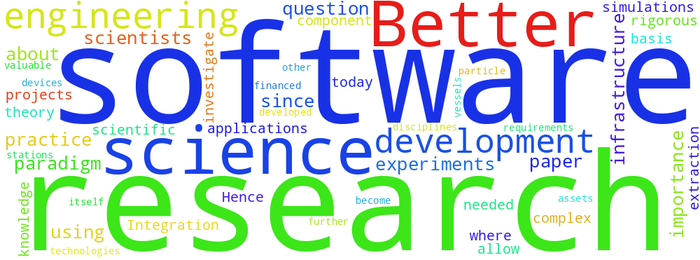
The Research Software Engineering Community at KIT has launched a new website as a source of information
The new page www.rse-community.kit.edu serves, among other things, as a starting point for those looking for information, events and services on the broad topic of Research Software Engineering (RSE). It is also intended to stimulate the exchange of knowledge on interesting RSE topics and issues.
Take a look and find out more about this new website: Here you can find out exactly what research software is and what we mean by Research Software Engineering. You will also find an extensive collection of links to sources of information at KIT, nationally and internationally. Feedback is possible and expressly welcome via the e-mail address given in the footer.
To the Website RSE-Community
Achim Grindler
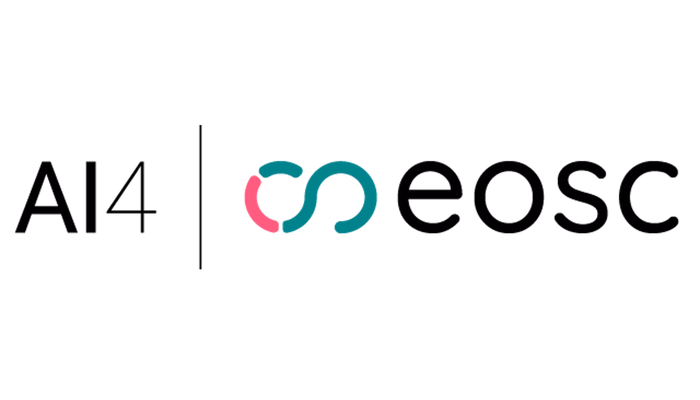
These three workshops give a detailed insight how to develop AI/ML/DL models and applications in the European Open Science Cloud (EOSC)
The AI4EOSC (Artificial Intelligence for the European Open Science Cloud), an EU-funded project that delivers an enhanced set of advanced services for the development of AI/ML/DL models and applications in the European Open Science Cloud (EOSC), organises a series of online workshops:
AI development in the EOSC
Day 1, March 22nd, 10:00 - 12:00 CEST: AI4EOSC platform introduction
Day 2, April 8th, 14:00 - 16:00 CEST: Image processing with AI4EOSC
Day 3, April 22nd, 14:00 - 16:00 CEST: Federated learning in the EOSC
For the overview, agenda and registration, please, visit ai4eosc.eu/events/ai4eosc-workshops-on-ai-development-in-the-eosc/
Contact at SCC: Dr. Valentin Kozlov
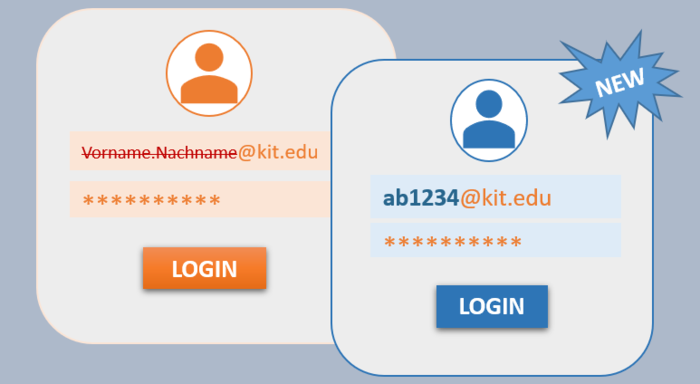
Login names for KIT employees in the form "vorname.nachname@kit.edu" will be discontinued. Authentication on systems can thus only be carried out via the personal KIT account in the form "ab1234" or "ab1234@kit.edu".
At currently, KIT employees log in to central KIT IT services (KIT mailbox, computers in kit.edu, etc.) with the currently valid login names in the form "kit\<ab1234>" or "<firstname.surname>@kit.edu".
The variant "<firstname.surname>@kit.edu" for KIT employees will now be changed to the new login name "<ab1234>@kit.edu".
The intention is to make the login name of a user account independent of a person's name change and to standardize the login name across all systems.
In addition, by standardizing the login name, for example, people who have agreed to use Microsoft Teams via https://my.scc.kit.edu will be able to use their Exchange calendar under Microsoft Teams in future.
The change will take place successively from 09:00 on Monday, 18.03.2024.
The login names will be changed successively, i.e. the individual user accounts of all KIT employees will be converted one by one. After the conversion of a user account, it will no longer be possible to log in to the central IT services of KIT with "<firstname.surname>@kit.edu" for this account. From this point on, the new login name "<ab1234>@kit.edu" of the user account must be used where "<firstname.surname>@kit.edu" was otherwise used for login.
Employees can find further information at:
KIT > SCC > Services > Working environment > User account (password) > KIT user account > Change login name.
The IT representatives in the organizational (ITB) units, who have already been informed about the change, will certainly help. However, queries can also be sent by email to it-support@scc.kit.edu.
SCC Service Team
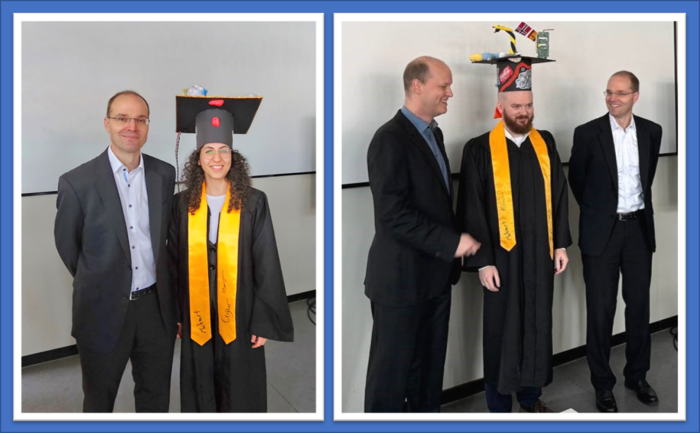
Almost the same time, on February 8 and 9, Elnaz Azmi and Oskar Taubert had the defense of their dissertations and were able to successfully complete their doctorates at the KIT Department of Informatics with this important step.
Ms. Elnaz Azmi successfully completed her dissertation on 8.2.2024. Since 2017, she has been working on the challenge of reducing the resource requirements of environmental simulations by using machine learning methods. One day later, Oskar Taubert was also able to celebrate the successful defense of his dissertation. Since 2018, Mr Taubert has been working on the machine learning of sparse data problems in biology and biologically inspired optimization algorithms adapted to high-performance computing (HPC).
Ms. Azmi has worked extensively with simulations in the environmental sciences, which are essential for the understanding of complex natural phenomena. Due to their high spatial and temporal resolution, these often impose high demands on available computing resources. In her research, Ms Azmi worked on increasing the efficiency of computationally intensive simulations by applying approximation and optimization approaches to examples from hydrology and climate science. The aim was to use machine learning to recognize similarities in time and space within the simulations and thus develop a method to reduce redundancies. By integrating an unsupervised learning module directly into the simulation code and replacing part of the simulation with a neural network, Ms. Azmi showed that by identifying model redundancies and reducing computational complexity, the efficiency of the simulations can be increased, thereby reducing resource requirements.
Mr. Taubert applied machine learning to the prediction of the structure of biomolecules. In order to make the best possible use of the limited training data available, he combined various methods: self-supervised neural networks, fine-tuning and gradient boosted decision trees. The parameterization of these complex model processes is made possible by algorithms adapted to the computing environment, which use the given computing resources efficiently to propose new models and train them. The contributions researched by Mr. Taubert on models generated with sparse data and on model architecture search should also be used in scientific machine learning in the future. Mr. Taubert's work was funded by the Helmholtz Analytics Framework (HAF) project, a "Google Faculty Research Award" received in the Multiscal Biomolecular Simulation research group and the Helmholtz Artificial Intelligence Cooperation Unit (Helmholtz AI) platform.
SCC congratulates Ms. Azmi and Mr. Taubert on successfully completing their doctorates and wishes them all the best for their future careers.
Dissertation of Elnaz Azmi: Approximation and Optimization of Compute-Intensive Environmental Simulations through Machine Learning Methods
Dissertation of Oskar Taubert: Machine Learning from Evolution
Achim Grindler
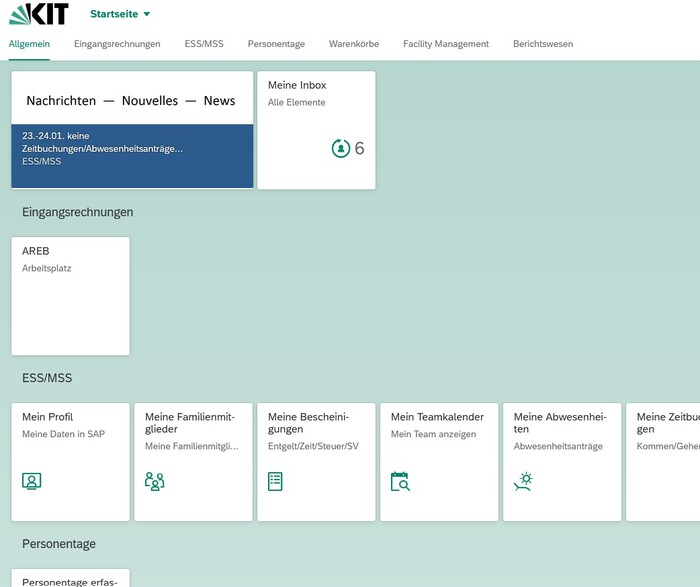
The SAP web portal was shut down at the end of 2023. The User Portal (UP) is now the central portal for employees for SAP-based digital administrative processes at KIT.
Translated with DeepL.com
Previously, KIT employees had access to various digital administration services (e.g. Employee Self Service, the Business Warehouse (BW) for financial and personnel reports and Supplier Relationship Management (SRM) for procurements) via the SAP web portal.
At the end of 2023, the SAP web portal was shut down and replaced by the User Portal (UP), which had been productive in parallel to the SAP web portal since fall 2022. UP is based on current SAP technologies and concepts, is now available in two languages - German and English - and can also be used on mobile devices with common web browsers. Over 15 apps are already available in UP. UP will be continuously expanded and new functions and apps added in 2024.
The replacement of the SAP web portal with the new portal is an important interim step in updating KIT's SAP system landscape. The next milestone is the planned replacement of the previous SRM system for self-service processes in procurement by the easyBANF solution integrated in UP in mid-2024.
Current information can be found in the UP service description
Martin Hengel
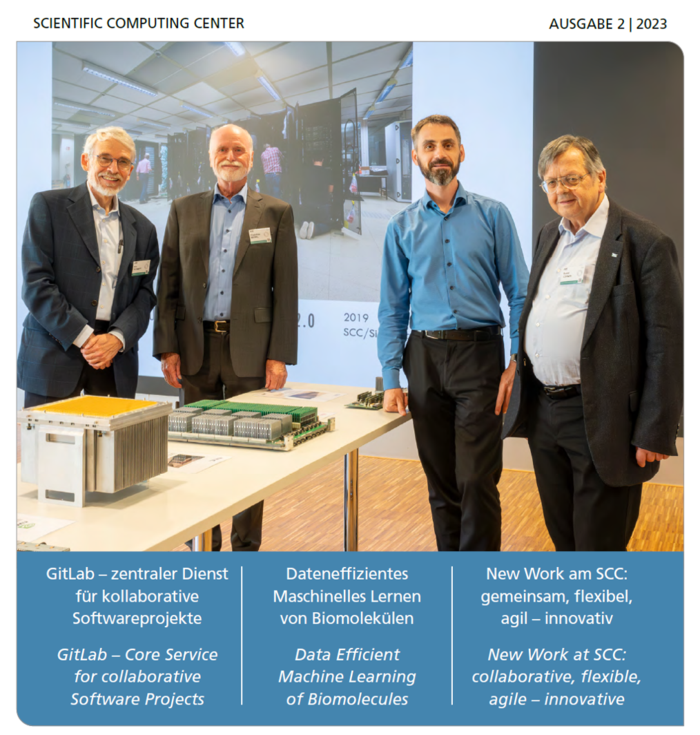
The new SCC News is online, including these topics: GitLab – Core Service for collaborative Software Projects; Data Efficient Machine Learning of Biomolecules; New Work at SCC: collaborative, flexible, agile – innovative.
Download SCC-News 2/2023
Dear reader,
At the beginning of a new year, we can reflect on the successes and challenges of the past year, on days and weeks that were beautiful and fulfilling, and on those difficult and exhausting. In this issue, we want to look back with you at what we have realized and how it builds on what we have already achieved. Over the past three years, the coronavirus pandemic has brought about several changes in our working world - home offices, virtual meetings, etc. At KIT, this has led to the question of how we can combine the advantages of the “old world” with the “new work” in a meaningful way to reach even greater satisfaction, agility, and flexibility in our work (p. 33).
Already ten years ago, the SCC was operating a central platform for collaborative software development at KIT. Gradually improved and following a sharp increase in demand from projects the platform is being modernized and expanded - a long way to go (p. 18). When looking at high-performance computing in Karlsruhe from its beginnings 40 years ago to the present day, the first “supercomputer” went into operation at the University of Karlsruhe in 1983. Since then, more than 30 supercomputers have been operated at KIT and its two predecessor institutions, which we properly celebrated with a festive colloquium (p. 35 and front page).
Sometimes however, it is worth looking back even further and asking whether the ancient processes of evolution also reveal clever approaches that help us to develop efficient algorithms to solve current problems. A new paper by SCC researchers on data-efficient machine learning of biomolecules confirms just that (p. 24).
And now on a personal note: from 1 January 2024 we will be looking into the future with a new name - Scientific Computing Center - but still with the same abbreviation SCC (p. 39) and wish you
happy reading.
Martin Frank, Bernhard Neumair, Martin Nußbaumer, Achim Streit
Achim Grindler
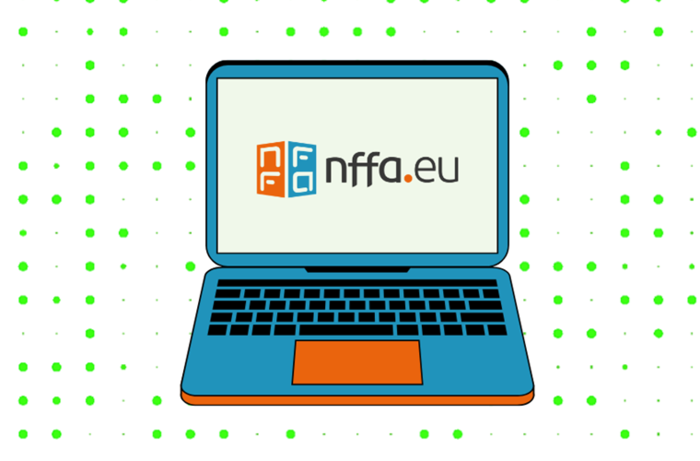
At the end of September 2023 the first set of Virtual Access (VA) services was released and integrated into the NFFA-Europe research infrastructure.
VA is a novelty in NFFA-Europe Pilot, which makes available online simulation and machine learning services, as well as data and metadata services, to the whole scientific community. The services currently target specific use cases, corresponding to the initial scientific needs they were designed for. The SCC strongly encourages feedback and contributions by the community in order to cover new use cases and to enhance the offer!
Project article on the NFFA-Europe website
Dr. Rossella Aversa
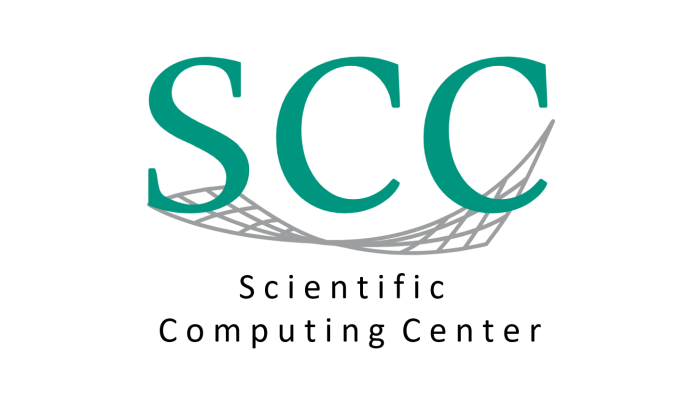
With the renaming, KIT is distancing itself from the namesake of the SCC, Karl Steinbuch. From January 1, 2024, Scientific Computing Center (SCC) will be the new name.
Translated with DeepL.com
Karl Steinbuch is considered a co-founder of computer science. The Information Technology Center of the Karlsruhe Institute of Technology (KIT) has been called the "Steinbuch Centre for Computing" since 2008. New findings now show that Karl Steinbuch, who researched and taught in Karlsruhe, already identified with unacceptable acts of war as a young man during the Nazi era. Regardless of his professional achievements, KIT is distancing itself from Steinbuch due to the new research findings and will therefore rename the KIT Information Technology Center the "Scientific Computing Center".
After Karl Steinbuch had shown a moderate political orientation in his scientifically creative phase, he turned to far-right positions after his retirement. Since it was already known in 2017 on Karl Steinbuch's 100th birthday that his views moved away from the political center with increasing age, that he turned to right-wing extremism after his retirement and regularly published articles in journals close to the far-right NPD at an advanced age, the KIT Executive Board expressly combined the recognition of Karl Steinbuch's professional achievements with the statement that KIT did not share the political views that Steinbuch held at an advanced age.
New findings about Karl Steinbuch
There are now new findings on Steinbuch's biography that show that even as a young man during the Nazi era, Karl Steinbuch identified with unacceptable acts of war (Anton F. Guhl: Kurskorrekturen eines Technokraten - Die politische Rechtswendung des Nachrichtentechnikers und Zukunftsforschers Karl Steinbuch nach 1970; Technikgeschichte Vol. 87 (2020) H. 4, pp. 315-334).
Name change from January 1, 2024
KIT has therefore decided to change the name of the Information Technology Center of KIT. The decision was confirmed in the KIT committees. KIT will implement the name change to "Scientific Computing Center" from January 1, 2024.
To the identical press release of KIT (german only)

SCC and Helmholtz-AI, in cooperation with FZJ and DLR, publish a study in Communications Biology that proposes how modern and classical deep machine learning methods can be combined in a data-efficient manner.
Translated with DeepL.com
Life is determined at the cellular level by various biomolecules. They constitute the machinery of living organisms and play a crucial role in the functioning of each cell. Machine learning is increasingly being used to study their function and related structure. Members of the Multiscale Biomolecular Simulation research group and the Helmholtz AI team, in cooperation with Forschungszentrum Jülich and the German Aerospace Center (DLR), have now proposed a method to combine modern and classical deep machine learning methods to build models even in data-poor scenarios.
The researchers use a deep learning approach to predict spatial neighborhoods between RNA building blocks (called nucleotides). Similar to what happens in a LEGO model, when individual Lego bricks are replaced in one location, the bricks in the neighborhood must adjust so that the entire structure still fits together. The BARNACLE model proposed in the study uses this idea for RNA: nucleotides that are spatially close together in RNA are also more likely to mutate together during evolution. And it is precisely these emergent mutation patterns that the model looks for. To train the model, it relies on a combination of self-supervised pre-training on lots of sequence data and efficient use of the few structural data. BARNACLE showed significant improvement with this approach over established classical statistical approaches but also other neural networks. It also shows that the method is transferable to related tasks with similar data constraints.
The results of this study were published in the paper "RNA Contact Prediction by Data Efficient Deep Learning" in the journal Communications Biology.
To the Communications Biology paper
Contact persons at SCC: Dr. Markus Götz, Oskar Taubert
Achim Grindler
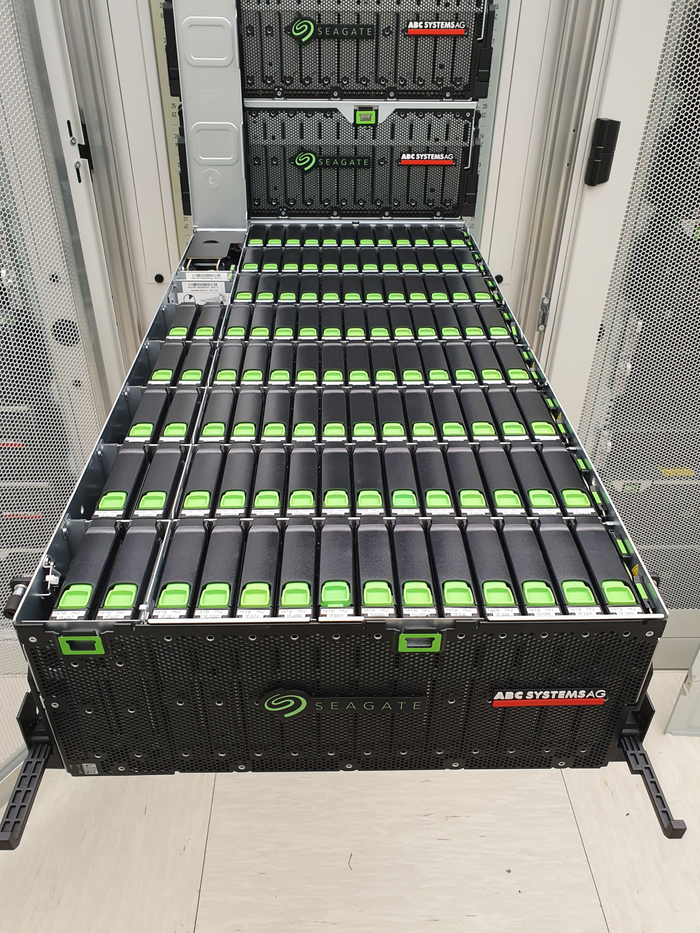
The Worldwide LHC Computing GridKa Tier-1 center is massively expanding its storage. An additional newly installed 71 petabytes of online storage are available. Data migration is now complete for almost all experiments.
In spring 2023, the expansion of the online storage system for the GridKa Tier-1 center in the Worldwide LHC Computing Grid at KIT was put into operation. The newly installed 71 petabytes are available to the LHC experiments ALICE, ATLAS, CMS, LHCb and the experiments Belle-II, Pierre Auger Observatory, Icecube and DARWIN and also replace 30 petabytes of storage hardware that will be decommissioned after six years. In total, GridKa now has 99 petabytes of online storage.
Unfortunately, the commissioning was delayed by a year due to the chip and logistics crisis following the Corona pandemic and the Ukraine war. The new installation consists of high-density Seagate CORVAULT systems with a total of 4664 18-terabyte hard drives, 70 servers and Infiniband switches that were integrated into the existing Infiniband network fabrics. IBM Storage Scale is used as the software-defined storage tier. The existing file systems were not extended, but new file systems were created. This allows new NVMe-based metadata storage systems to be deployed and new features of IBM Storage Scale to be used. The data for almost all experiments has already been migrated and the systems are in productive operation.
Contact at SCC: Dr. Serge Sushkov
Achim Grindler

On September 14, KIT celebrated the 40-year era of high-performance computing in Karlsruhe with a festive colloquium. The invited guests enjoyed the opportunity to learn and exchange information about the entire range of HPC in Karlsruhe.
Translated with DeepL.com
On September 14, 2023, the SCC celebrated the era of high-performance computing, which has already spanned 40 years in Karlsruhe, with an internal festive colloquium. The invited guests from research policy and management, data center planning, construction and operation, as well as scientists, both former and active, were able to learn first-hand about the entire range of 40 years of high-performance computing in Karlsruhe during lectures, panel discussions, as well as an exhibition and guided tours. There was plenty of room to review successes and challenges, to philosophize a bit about the future, and of course to celebrate together and share interesting stories.
In his welcoming remarks, Peter Castellaz, the head of the department responsible for HPC at the Baden-Württemberg Ministry of Science, Research and the Arts (MWK), highlighted the state's bwHPC strategy, with which the SCC has not only implemented important aspects of content, but also played a leading role in an intensively lived culture of cooperation. "In addition to the HPC-specific resources and the associated methodological knowledge, KIT has successfully contributed in particular with its expertise in the field of data and research software", says Peter Castellaz. He finds words of praise for the state-wide federated identity management bwIDM, with which the SCC, together with other state institutions, has developed decisive basic requirements for cooperatively provided services - also beyond HPC. In order to accentuate not only technological developments but also the topics of research software and sustainability, a comprehensive state strategy is being worked out until 2032, Peter Castellaz lets it be known.
In her welcoming remarks, KIT Vice President for Digitization and Sustainability Kora Kristof is impressed by the community that has developed over a long period of time in the HPC environment, starting with the Gauss Centre for Supercomputing (GCS) and continuing with the different centers at the Tier-2 (Gauss Alliance) and Tier-3 levels, nationally and in Baden-Württemberg. "What has been developed in HPC by KIT and other institutions at the state level has also helped shape developments nationally, and special thanks are due for that," Kora Kristof notes. In addition, KIT has combined high-performance computing with the topic of energy efficiency and achieved outstanding successes with it. Here, the German Computing Center Award 2017 for ForHLR II and 13th place on the international best list of the most energy-efficient computers for HoreKa speak for themselves. "And in the future, many interesting topics that shape sustainability will also occupy us in the HPC environment - this concerns sustainable buildings and infrastructures, the use of sustainable materials and resource conservation, as well as aspects of sustainable software" predicts Kora Kristof.
Transitioning to the technical presentations, Martin Frank, director of the SCC, characterized the HPC business as a mix of something very dynamic and something conservative. "The dynamic can be seen very clearly in the development of HPC systems over the last 40 years, the conservative is, for example, in the handling of very complex processes such as procurement and the secure operation of the infrastructure," Martin Frank concretizes in his welcoming speech, knowing that experience and innovation are the important poles in the HPC business that make the SCC an important player in national high-performance computing. "All this ensures that scientists are supported in the best possible way in their research with high-performance computers and research software."
In the first technical lecture, Eric Schnepf introduced the beginnings of high-performance computing in Karlsruhe and covered developments up to the present. He made his first IT experiences in the 1970s at the University of Karlsruhe with Algol programs, which he created on punched tape using a Siemens T100 teletype and ran on the Zuse Z 23. In the 80s, in addition to universal computers, he was able to familiarize himself with vector computers, on which it was possible to compute applications more accurately and faster. Eric Schnepf dates the beginning of the HPC era in Karlsruhe to May 1983, when a state vector computer, a Cyber 205, was installed and operated at the University Computing Center in Karlsruhe after previous tests on a similar machine at the University of Bochum. User support was provided by a team from the University of Karlsruhe and what was then the Karlsruhe Nuclear Research Center (KfK). "The procurement only came about because a large community worked very well together: university, KfK and industry partners" affirms Eric Schnepf in his presentation. In addition to many interesting technical excursions into the world of the computer systems installed at the university at that time, Eric Schnepf also gave examples of applications - for example, from climate research - and went into detail about the ODIN cooperation created between Siemens-Nixdorf and the university, which stands for Optimal Data Models and Algorithms for Engineering and Natural Sciences on High-Performance Computers. A milestone was the first TOP500 list of supercomputers, which appeared in 1993. The original handout shows the German list with the two first-placed S600/20 systems from Karlsruhe and Aachen. Eric Schnepf rounded off his presentation with an overview slide of the most important HPC systems of the last 40 years in Karlsruhe, placing them in the borderlines of the TOP500 (rank 1 .. rank 500). "From Cyber 205 (1983) to HoreKa (2023), that's eight powers of ten performance increase, so on average every 10 years factor 100 acceleration. I think that's something to be proud of," says Eric Schnepf, appreciating the development at the HPC in Karlsruhe.
Klaus-Peter Mickel, physicist and former director of the SCC, was already working as a programmer for the IBM machines at the Computing Center of the Karlsruhe Research Center (FZK) at the end of the 1960s and also experienced and shaped the developments of the high-performance computing systems in Karlsruhe from the very beginning. When he accepted a position at the Karlsruhe Computing Center in 1970, he took over the supervision of university employees who wanted to use the FZK machines. After various professional stations, Klaus-Peter Mickel then took over the management of the computer center at the FZK in 1996. In his review of the years between 1966 and 1996, Klaus-Peter Mickel describes the intensive cooperation between the computer experts at the university and the FZK, which finally, starting in 1996, led to the planning of a sophisticated technical and organizational cooperation between the two scientific computer centers - the Virtual Computer Center Karlsruhe was founded. Virtual, yes, because it did not come to a joint computing center of both institutions at one location, as originally considered, but to an association with a legally secured cooperation agreement. There was a joint management committee and different architectural focuses on both sides, each with mutually contributed resources. The university focused on massively parallel computers and the FZK on vector computers, which were very powerful at the time. A dedicated data line connected the two computing centers over 10 km as the crow flies, reaching the respectable speed of 155 megabits per second at the time. Many positive effects were achieved by setting up the virtual data center. In addition to a high level of efficiency, because both sides did not have to maintain both architectures, there was a great benefit for the user groups because they had both architectures at their disposal.
In his lecture, Rudolf Lohner gave an intensive insight into the origins of the university's computing center and the associated development as well as the operation of the massively parallel computers in Karlsruhe, the so-called computing clusters. Rudolf Lohner worked for 20 years for the mathematics professors Alefeld and Kulisch, whom he credited as pioneers of the first hours and founders of the university computer center. He then moved from the Mathematics Institute to the Computing Center at the University of Karlsruhe in the 2000s and was an expert on energy efficiency in high-performance computing centers at the SCC until the end of his active career. In the mid-1990s, massively parallel computing clusters became increasingly common, and such systems have also been operated for research purposes at the university's computing center over the last few years, right up to the present day. Rudolf Lohner presented in an entertaining ramble not only the different cluster systems, but also some important projects and application scenarios. The spectrum ranges from the mathematical simulation of sailboat characteristics for the America's Cup, to the generation of precise weather forecasts, to the development of the institute's own cluster management systems. For the Karlsruhe High Performance Computer (HoreKa) operated today at the SCC and its predecessor systems ForHLR I and ForHLR II, Rudolf Lohner designed the extremely efficient energy and operating concept together with the HPC team. The associated new building was completed in 2015 and houses HPC systems that can be used throughout Germany at KIT's North Campus. A few months ago, the necessary structural and technical preparations were completed to make the building fit for future, even much more powerful computing systems with up to 2 megawatts of power consumption.
Following the exciting technical presentations, which highlighted the entire 40 years of HPC in Karlsruhe from various angles, guests were able to take part in guided tours of the HPC infrastructure as well as admire data center exhibits from the last 40 years in a specially designed exhibition room.
The SCC would like to thank the Ministry of Science, Research and the Arts of Baden-Württemberg, the KIT Presidium, all those involved in shaping and consistently developing 40 years of HPC in Karlsruhe, as well as the organization team of this festive colloquium around Simon Raffeiner (see photo), and of course all its guests.
Achim Grindler
Photos: Markus Breig (KIT)
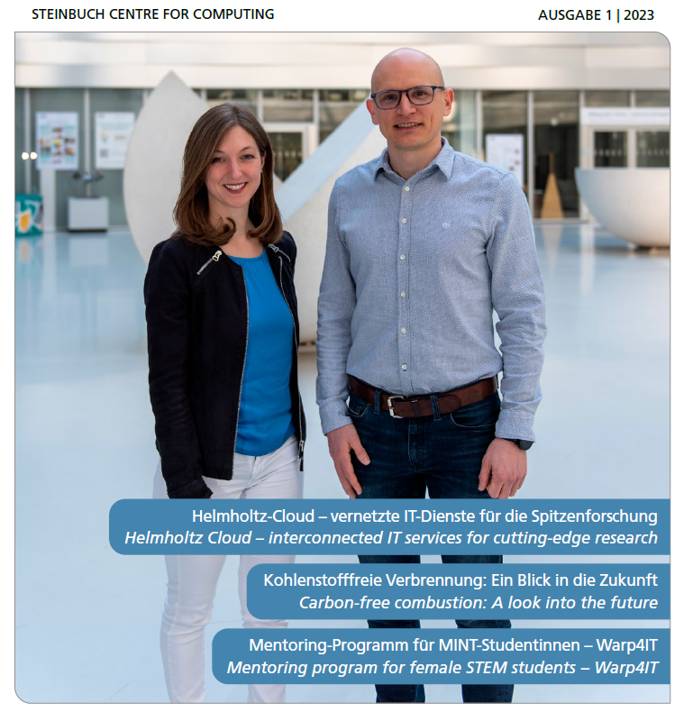
The new SCC News is online, including these topics: Helmholtz-Cloud – interconnected IT services for cutting-edge research; Carbon-free combustion: A look into the future; Mentoring program for female STEM Students – Warp4IT
Download SCC-News 1/2023
Dear reader,
the cloud remains trending. Increasingly services that were operated locally are moved to the cloud or they operate in the cloud from the very beginning. Not only in industry, also in scientific institutions the number of cloud applications continues to increase. Following suit, the Helmholtz Centres have started to build a common cloud (p. 8). Each centre contributes services and applications which are offered via a user-friendly portal. For the joint service and quality concept the centres intensively exchanged information to reach agreement on common procedures and standards. This is why, among other things, services for digital communication played an important role while developing the Helmholtz Cloud.
However, remote communication may not always be sufficient for collaborating effectively. People from SCC have started travelling and meeting again at international conferences (p. 15) or went to longer research stays all over the world. On page 16, we discuss research that was conducted by Thorsten Zirwes during a DAAD scholarship at the prestigious Stanford University, on the feasibility of achieving CO2-free combustion of ammonia in porous materials.
The spectrum of scientific cooperation and communication at KIT is immense. Junior research groups or mentoring programs bring together individuals from diverse backgrounds and experiences. Charlotte Debus and Sebastian Krumscheid (cover photo) started their new research groups at SCC (p. 22) and female scientists at SCC have set up a mentoring programme for female MINT students at KIT. The program involves overseeing computer science projects for female students and providing them with an understanding of what everyday scientific life entails (p. 18 and 23).
Enjoy reading the new issue of SCC-News
Martin Frank, Bernhard Neumair, Martin Nußbaumer, Achim Streit
Achim Grindler
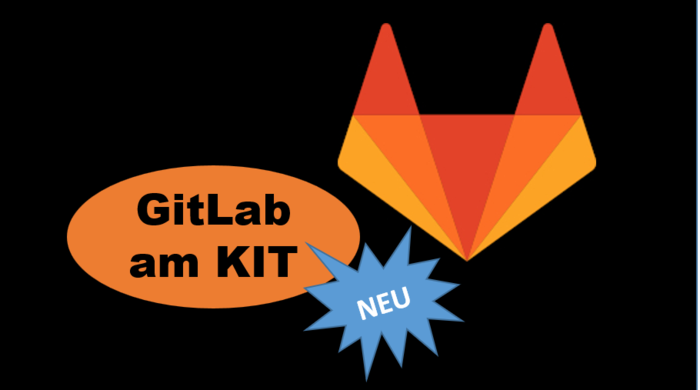
After a successful pilot operation, the SCC has now set up the IT infrastructure for central version management with GitLab. The service "GitLab at KIT" can be used by all employees and students at KIT from the beginning of July 2023.
In software development, "git" has become the de facto standard as a tool for decentralized version management in recent years. Based on this, GitLab offers a web application for project management, documentation, bug tracking, build creation and deployment including continuous integration.
Possible application scenarios at KIT include courses on programming as well as software development in research (also RSE). In addition, the platform is also suitable for managing text-based documents, e.g. in the markup languages like LaTeX or Markdown.
After the discontinuation of SVN and a successful pilot operation of git.scc.kit.edu, the SCC has set up the cluster operation for the new central service "GitLab at KIT" in the last few months and now makes the development platform available for use by all KIT members.
Information about the features of the service and their possible uses can be found in the service description for the "GitLab at KIT" service.
However, if you have any questions, please feel free to contact us using the contact information provided in the service description.
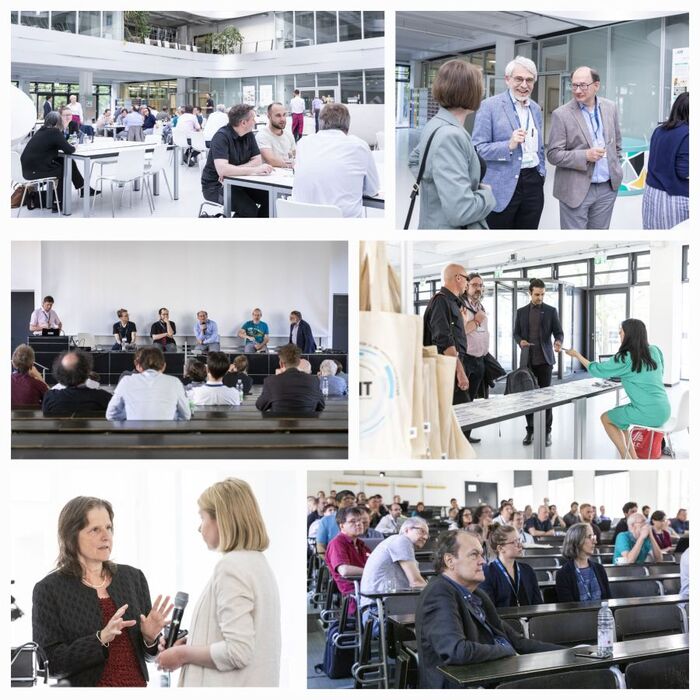
From 31.5-2.6.23, the SCC hosted the HPC Status Conference of the Gauss Alliance, which for the 12th time provided researchers with a platform for interdisciplinary exchange and networking in the field of high-performance computing in Germany.
SCC hosted the 12th annual status conference of the Gauss Alliance, which focused on sustainable computing and AI. In times of energy crises, climate change and the beginning of the Exascale era, HPC centers are facing numerous challenges. To reconcile the race towards ever larger and faster systems with the scarcity of resources, clever solutions are needed in both the hardware and software areas.
VP Prof. Kora Kristof addressed these tensions in her welcoming address and emphasized the importance of the SCC not only as an HPC provider for researchers at KIT, but also our role in the state network bwHPC and the national network NHR.
For the first keynote speech we welcomed Dr. Stefan Schenk from BASF, who focused on HPC applications in the chemical industry. Today, simulations have become an integral part of every economic field and are used everywhere from medical research to detergent development.
The BMBF-funded GreenHPC projects presented projects such as ESN4NW and WindHPC. They aim to create data centers directly where energy is produced: in wind turbines. The massive towers offer sufficient protection and storage space, the green energy is fed in directly and the height of the mast is utilized for the necessary cooling.
But the hardware sector is not the only area that is undergoing exciting changes. The software sector is likewise preparing for the Exascale era. The BMBF's so-called ScaleExa projects have set themselves the goal of developing scalable and innovative methods to be able to use future systems in a time and energy-efficient manner. The SCC is represented within the EXASIM project by the junior research group FiNE. The goal is to link the open source software OpenFOAM to the Ginkgo library via a special software layer which then enables OpenFOAM to run on GPUs. This shortens the computing time and thus saves energy.
With exciting new tools such as ChatGPT or Mindjourney, there is a gold-rush atmosphere in the AI sector. Driven by ever new fields of application, the AI research landscape is growing rapidly. Growing demand for computing resources coupled with the uncertain development of energy costs increases the need for collaborations between HPC providers and HPC users. In the closing keynote speech on "AI in the age of exascale computing" our junior research group leader Dr. Charlotte Debus explored these and other questions that will be faced by the HPC and AI community in the coming years.
Dr. Jasmin Hörter

Propulate is a software that solves very general optimization problems using genetic algorithms. It is specifically designed for high-performance systems, easy to use and publicly available.
With Propulate, we provide a software for solving optimization problems that is especially adapted to the HPC setting. It is openly accessible and easy to use. Compared to a widely used competitor Propulate is faster - for a set of typical benchmarks at least an order of magnitude - and in some cases even more accurate.
Propulate is inspired by biology, in particular by evolution, that is selection, recombination, and mutation. Propulate uses mechanisms inspired by biological evolution, such as selection, recombination, and mutation. Evolution begins with a population of solution candidates each with randomly initialized genes. It’s an iterative process where the population at each iteration is called a generation. For each generation, the fitness of each candidate in the population is evaluated. The genes of the fittest candidates are incorporated in the next generation (see explanatory video).
Like in nature, propulate does not wait for all compute units to finish evaluation of the current generation. Instead, the compute units communicate the currently available information and use that to breed the next candidate immediately. This avoids waiting idly for other units and in consequence a load imbalance. Each unit is responsible for the evaluation of a single candidate. The result is a fitness level belonging to the genes of that candidate, allowing to compare and rank the candidates. This information is sent to other compute units as it becomes available. When a unit is finished evaluating a candidate and communicating the resulting fitness, it breeds the candidate for the next generation using the fitness values of all the candidates it evaluated and received from other units so far.
Propulate can be used for hyperparameter optimization and neural architecture search. It was already successfully applied for several accepted scientific publications. Applications include grid load forecasting, remote sensing, and structural molecular biology.
Further Information:
Propulate Code Repository
Explanatory video
Paper Massively Parallel Genetic Optimization through Asynchronous Propagation of Populations
Contact at SCC: Dr. Marie Weiel, Oskar Taubert
Achim Grindler

